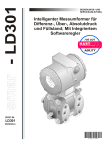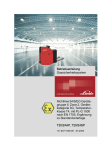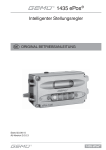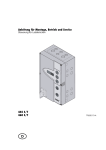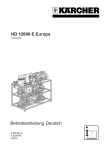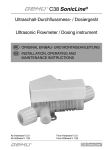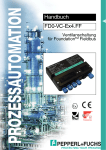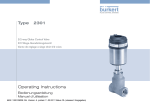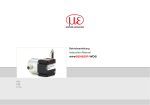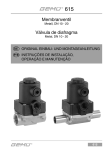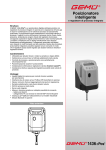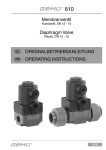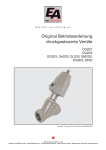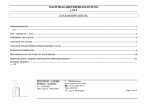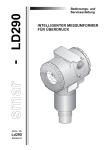Download ba-gemue-566
Transcript
566 Regelventil Metall, DN 8 - 15 Control Valve Metal, DN 8 - 15 DE ORIGINAL EINBAU- UND MONTAGEANLEITUNG GB INSTALLATION, OPERATING AND MAINTENANCE INSTRUCTIONS 566 Inhaltsverzeichnis 1 2 2.1 2.2 2.3 3 4 5 5.1 5.2 5.3 5.4 6 6.1 6.2 6.3 7 7.1 7.2 7.3 7.4 8 9 9.1 9.2 9.3 10 10.1 10.2 10.3 10.4 10.4.1 10.4.2 10.5 11 11.1 11.2 11.3 11.3.1 11.3.2 11.3.3 11.3.4 11.3.5 Allgemeine Hinweise 3 Allgemeine Sicherheitshinweise 3 Hinweise für Serviceund Bedienpersonal 3 Warnhinweise 4 Verwendete Symbole 4 Begriffsbestimmungen 4 Vorgesehener Einsatzbereich 5 Technische Daten 5 Technische Daten – manuell betätigt 5 Technische Daten – pneumatisch betätigt 6 Technische Daten – elektromotorisch betätigt 6 Kv-Werte 6 Bestelldaten 7 Bestelldaten – manuell betätigt 7 Bestelldaten – pneumatisch betätigt 7 Bestelldaten – elektromotorisch betätigt 8 Herstellerangaben 9 Transport 9 Lieferung und Leistung 9 Lagerung 9 Benötigtes Werkzeug 9 Funktionsbeschreibung 9 Geräteaufbau 9 Pneumatische Ausführung 9 Manuelle Ausführung 10 Elektromotorische Ausführung 10 Montage und Anschluss 10 Montage des Ventils 10 Steuerfunktion (pneumatisch betätigt) 11 Steuermedium anschließen 12 Optische Stellungsanzeige 12 Manuelle Ausführung 12 Elektromotorische Ausführung 12 Regler anbauen, anschließen und einstellen (pneumatisch betätigt) 12 Elektrische Anschlüsse (elektromotorisch betätigt) 12 Funktionsweise des Antriebs 12 Vorgehensweise 13 Anschlusspläne 14 Funktionsmodul E1 14 Funktionsmodul E2 14 Funktionsmodul E3 14 Funktionsmodul AE 15 Funktionsmodul AP 15 566 11.3.6 Funktionsmodul AE AUF/ZU Steuerung mit 2 zusätzlichen Endlagenrückmeldungen und Hirschmannstecker N 6 R AM2 (Ausführungsart: 6027) 15 11.3.7 Funktionsmodul AP AUF/ZU Steuerung mit Potentiometerausgang und Hirschmannstecker N 6 R AM2 (Ausführungsart: 6027) 15 12 Einstellungen (elektromotorisch betätigt) 16 12.1 Einstellung Parameter 16 12.1.1 RESET - Sollwerteingang in die Werkseinstellung zurücksetzen für E1 / E2 / E3 17 12.1.2 Elektrische Schließbegrenzung für E1 / E2 - Stellung des Ventils bei Sollwert 0 V bzw. 0 / 4 mA neu programmieren 17 12.1.3 Elektrische Öffnungsbegrenzung für E1 / E2 - Stellung des Ventils bei Sollwert 20 mA neu programmieren 17 12.1.4 Einstellung der Totzone 17 13 Dichtheit des Ventils prüfen 18 14 Montage / Demontage von Ersatzteilen 18 14.1 Antrieb austauschen 18 14.1.1 Demontage Antrieb (Antrieb von Regelmechanik lösen) 18 14.1.2 Montage Antrieb auf Regelmechanik 19 14.2 Regelkegel austauschen 19 14.2.1 Demontage Regelkegel 19 14.2.2 Montage Regelkegel 19 14.3 Trennmembrane austauschen 20 14.3.1 Demontage Trennmembrane 20 14.3.2 Montage Trennmembrane 20 15 Inbetriebnahme 20 16 Inspektion und Wartung 20 17 Demontage 21 18 Entsorgung 21 19 Rücksendung 21 20 Hinweise 21 21 Fehlersuche / Störungsbehebung 22 22 Schnittbilder und Ersatzteile 23 22.1 Manuelle Ausführung 23 22.2 Pneumatische Ausführung 24 22.3 Elektromotorische Ausführung 25 23 Einbauerklärung 26 24 Konformitätserklärung 28 25 Herstellererklärung 29 2 / 60 1 Allgemeine Hinweise Beschreibungen und Instruktionen beziehen sich auf Standardausführungen. Für Sonderausführungen, die in dieser Einbau- und Montageanleitung nicht beschrieben sind, gelten die grundsätzlichen Angaben in dieser Einbau- und Montageanleitung in Verbindung mit einer zusätzlichen Sonderdokumentation. Alle Rechte wie Urheberrechte oder gewerbliche Schutzrechte werden ausdrücklich vorbehalten. Voraussetzungen für die einwandfreie Funktion des GEMÜ-Ventils: Sachgerechter Transport und Lagerung. Installation und Inbetriebnahme durch eingewiesenes Fachpersonal. Bedienung gemäß dieser Einbau- und Montageanleitung. Ordnungsgemäße Instandhaltung. Korrekte Montage, Bedienung und Wartung oder Reparatur gewährleisten einen störungsfreien Betrieb des Ventils. 2 Allgemeine Sicherheitshinweise Die Sicherheitshinweise berücksichtigen nicht: Zufälligkeiten und Ereignisse, die bei Montage, Betrieb und Wartung auftreten können. die ortsbezogenen Sicherheitsbestimmungen, für deren Einhaltung – auch seitens des hinzugezogenen Montagepersonals – der Betreiber verantwortlich ist. 2.1 Hinweise für Serviceund Bedienpersonal Die Einbau- und Montageanleitung enthält grundlegende Sicherheitshinweise, die bei Inbetriebnahme, Betrieb und Instandhaltung zu beachten sind. Nichtbeachtung kann zur Folge haben: Gefährdung von Personen durch elektrische, mechanische und chemische Einwirkungen. Gefährdung von Anlagen in der Umgebung. Versagen wichtiger Funktionen. Gefährdung der Umwelt durch Austreten gefährlicher Stoffe bei Leckage. Vor Inbetriebnahme: Einbau- und Montageanleitung lesen. G Montage- und Betriebspersonal ausreichend schulen. G Sicherstellen, dass der Inhalt der Einbauund Montageanleitung vom zuständigen Personal vollständig verstanden wird. G Verantwortungs- und Zuständigkeitsbereiche regeln. G Bei Betrieb: G Einbau- und Montageanleitung am Einsatzort verfügbar halten. G Sicherheitshinweise beachten. G Nur entsprechend der Leistungsdaten betreiben. G Wartungsarbeiten und Reparaturen dürfen nur durch GEMÜ vorgenommen werden. GEFAHR Sicherheitsdatenblätter bzw. die für die verwendeten Medien geltenden Sicherheitsvorschriften unbedingt beachten! Bei Unklarheiten: Bei nächstgelegener GEMÜVerkaufsniederlassung nachfragen. 3 / 60 566 2.2 Warnhinweise 2.3 Warnhinweise sind, soweit möglich, nach folgendem Schema gegliedert: Verwendete Symbole Gefahr durch heiße Oberflächen! SIGNALWORT Gefahr durch ätzende Stoffe! Art und Quelle der Gefahr ® Mögliche Folgen bei Nichtbeachtung. G Maßnahmen zur Vermeidung der Gefahr. Hand: Beschreibt allgemeine Hinweise und Empfehlungen. Warnhinweise sind dabei immer mit einem Signalwort und teilweise auch mit einem gefahrenspezifischen Symbol gekennzeichnet. Folgende Signalwörter bzw. Gefährdungsstufen werden eingesetzt: G ® Punkt: Beschreibt auszuführende Tätigkeiten. Pfeil: Beschreibt Reaktion(en) auf Tätigkeiten. Aufzählungszeichen GEFAHR Unmittelbare Gefahr! ® Bei Nichtbeachtung sind Tod oder schwerste Verletzungen die Folge. WARNUNG Möglicherweise gefährliche Situation! ® Bei Nichtbeachtung drohen schwerste Verletzungen oder Tod. VORSICHT Möglicherweise gefährliche Situation! ® Bei Nichtbeachtung drohen mittlere bis leichte Verletzungen. 3 Betriebsmedium Medium, das durch das Ventil fließt. Steuermedium Medium mit dem durch Druckaufbau oder Druckabbau das Ventil angesteuert und betätigt wird. Steuerfunktion Mögliche Betätigungsfunktionen des Ventils. VORSICHT (OHNE SYMBOL) Möglicherweise gefährliche Situation! ® Bei Nichtbeachtung drohen Sachschäden. 566 Begriffsbestimmungen 4 / 60 4 Vorgesehener Einsatzbereich WARNUNG Ventil nur bestimmungsgemäß einsetzen! ® Sonst erlischt Herstellerhaftung und Gewährleistungsanspruch. G Das Ventil ausschließlich entsprechend den in der Vertragsdokumentation und in der Einbau- und Montageanleitung festgelegten Betriebsbedingungen verwenden. G Das manuell oder pneumatisch betätigte Ventil nur in explosionsgefährdeten Zonen verwenden, die auf der Konformitätserklärung (ATEX) bestätigt wurden. G Das elektromotorisch betätigte Ventil nicht in explosionsgefährdeten Zonen verwenden. Das 2/2-Wege-Regelventil GEMÜ 566 ist für den Einsatz in Rohrleitungen konzipiert. Es steuert ein durchfließendes Medium durch einen Hand-, Pneumatikoder Motorantrieb. Das Ventil darf nur gemäß den technischen Daten eingesetzt werden (siehe Kapitel 5 "Technische Daten"). Pneumatische und elektromotorische Ausführung: Der direkte oder externe Anbau eines Reglers (GEMÜ 1434 μPos®, GEMÜ 1436 cPos®) ist sinnvoll. 5 Technische Daten Betriebsmedium Betriebsdruck Aggressive, neutrale, gasförmige und flüssige Medien, die die physikalischen und chemischen Eigenschaften des jeweiligen Gehäuse- und Membranwerkstoffes nicht negativ beeinflussen. Medientemperatur 80 °C CIP max. 30 min (Trennmembranwerkstoff-Code 33) 85 °C Betriebsdruck 5.1 0 - 6 bar Sämtliche Druckwerte sind in bar - Überdruck angegeben. Ventilkörper sind bis PN 10 zugelassen. Leckrate DIN IEC 60534-4 IV L 1 Technische Daten – manuell betätigt Antriebswerkstoff Umgebungsbedingungen Umgebungstemperatur max. 60 °C 5 / 60 Oberteil A4 Edelstahl, (1.4408) Kappe PEEK Handrad A4 Edelstahl, (1.4408) 566 5.2 Technische Daten – pneumatisch betätigt Umgebungsbedingungen Steuermedium Umgebungstemperatur max. 60 °C Betriebsdruck [bar] Steuerdruck [bar] 0-6 4,5 - 7 bar Neutrale Gase Max. zul. Temperatur des Steuermediums 70 °C Füllvolumen: 0,03 dm³ Sämtliche Druckwerte sind in bar - Überdruck angegeben. Ventilkörper sind bis PN 10 zugelassen. 5.3 Technische Daten – elektromotorisch betätigt Umgebungsbedingungen Schutzart Umgebungstemperatur -15 ... +55 °C IP 65 nach EN 60529 Stellzeit Elektrische Daten Spannungsversorgung Leistungsaufnahme Einschaltdauer Elektrischer Anschluss 2 x PG 13,5 2 x Rundsteckverbinder (Binder Serie 717) 5.4 Uv = 24 V 50/60 Hz ± 10 % Uv = 120 V 50/60 Hz ± 10 % Uv = 230 V 50/60 Hz ± 10 % 3,5 VA Siehe Antriebsausführung Kapitel 6.3 ca. 17 bzw. 45 s Eingangswiderstand 33 Ω (Eingang durch Verpoldiode geschützt) 100% Ausführung Funktionsmodul AE, AP Ausführung Funktionsmodul E1, E2, E3 Kv-Werte Gleichprozentig (Code 1) Regelkurve G G G G G G G G G Kv-Wert [l/h] 63 100 160 250 400 630 1000 1600 2500 DN 8 X X X X X X - DN 10 X X - Linear (Code 1) DN 15 X DN 15 X X X X X X X X - Regelkurve L L L L L Kv-Wert [l/h] 100 250 630 1600 2500 DN 20 X DN 8 X X X - DN 10 X - DN 15 X DN 15 X X X X - DN 20 X 100 80 Kv-Wert [l/h] [%] Kv-Wert Kv-Wert [l/h] 63 100 160 250 400 630 1000 1600 2500 Kv-Wert [l/h] 100 250 630 1600 2500 Linear (Code 88) Gleichprozentig (Code 88) Regelkurve G G G G G G G G G Regelkurve L L L L L 60 L G 40 20 0 20 40 60 Hub[%] [%] Hub 566 6 / 60 80 100 6 Bestelldaten Gehäuseform Code Durchgangskörper D Anschlussart Trennmembranwerkstoff 1 Clamp ASME BPE für Rohr ASME BPE, Baulänge EN 558, Reihe 7 Code 1.4435 (ASTM A 351 CF3M ≙ 316L), Feinguss Code Gewindemuffe DIN ISO 228 6.1 Ventilkörperwerkstoff C1 Code FPM 4 EPDM 88 33 Bestelldaten – manuell betätigt Steuerfunktion Code Manuell betätigt Regelcharakteristik 0 Antriebsausführung Code Standard 1TN Verriegelung 1TB* 566 Typ 566 Nennweite 8 D G* L* * Auswahlschema siehe Diagramm Kapitel 5.4 Kv-Wert siehe Kapitel 5.4 Kv-Werte: Toleranz ±10% * Hub in 7,5% Schritten wirksam Bestellbeispiel Code Gleichprozentig Linear 1 C1 4 0 1TN G 63 8 Gehäuseform (Code) D Anschlussart (Code) 1 Ventilkörperwerkstoff (Code) C1 Trennmembranwerkstoff (Code) 4 Steuerfunktion (Code) 0 1TN Antriebsausführung (Code) Regelcharakteristik (Code) G Kv-Wert 63 EDV-Nr. Bezeichnung 88264576 653MAGSV1 C1 AT 88232776 653MAGSV1 C1 88279388 653MAGSV2 C1 88239348 88239405 653LOCSVL 653LOCSVB 6.2 Beschreibung Elektrisch magnetische Verriegelungseinheit 24 V DC, stromlos geschlossen, M22x1 ATEX Elektrisch magnetische Verriegelungseinheit 24 V DC, stromlos geschlossen, M22x1 IP 54, Gerätesteckdose Bauform A DIN EN 175301-803 Elektrisch magnetische Verriegelungseinheit 24 V DC, stromlos offen, M22x1 IP 54, Gerätesteckdose Bauform A DIN EN 175301-803 Verriegelungseinheit M22x1 mit Bügelschloss Verriegelungseinheit M22x1 ohne Bügelschloss Bestelldaten – pneumatisch betätigt Steuerfunktion Federkraft geschlossen (NC) Antriebsausführung Antriebsausführung Code Regelcharakteristik 1 Code Gleichprozentig Linear Code G* L* * Auswahlschema siehe Diagramm Kapitel 5.4 1T1 Kv-Wert siehe Kapitel 5.4 Kv-Werte: Toleranz ±10% 7 / 60 566 Bestellbeispiel 566 Typ 566 8 Nennweite D 1 C1 4 1 1T1 G 63 8 Gehäuseform (Code) D Anschlussart (Code) 1 Ventilkörperwerkstoff (Code) C1 Trennmembranwerkstoff (Code) 4 Steuerfunktion (Code) 1 Antriebsausführung (Code) 1T1 Regelcharakteristik (Code) G Kv-Wert 63 Um ein komplettes Regelventil zu konfigurieren, muss das pneumatisch betätigte Basisventil mit einem elektropneumatischen Regler kombiniert werden. Dazu stehen die Stellungs- und Prozessregler GEMÜ 1434 μPos® und 1436 cPos® zur Verfügung. 6.3 Bestelldaten – elektromotorisch betätigt Anschlussspannung / Netzfrequenz 24 V 50/60 Hz C4 120 V 50/60 Hz G4 230 V 50/60 Hz L4 Funktionsmodul Regelcharakteristik Code AE AUF / ZU Steuerung mit Potentiometerausgang AP Stellungsregelung Ventilposition, Istwert im Antrieb intern, Potentiometer Sollwert extern, 0 - 10 V E1 Stellungsregelung Ventilposition, Istwert im Antrieb intern, Potentiometer Sollwert extern, 0/4 - 20 mA E2 Prozessgrößenregelung, Istwert extern, 0/4 - 20 mA, Sollwert extern, 0/4 - 20 mA E3 Bestellbeispiel 566 Typ 566 Nennweite Gehäuseform (Code) Anschlussart (Code) siehe Kapitel 5.4 Kv-Wert Kv-Werte: Toleranz ±10% Antriebsausführung 8 D 1 Code Stellzeit 17 sec. A0 Stellzeit 45 sec. A1 C1 4 C4 AE G 63 A0 8 D 1 Ventilkörperwerkstoff (Code) C1 Trennmembranwerkstoff (Code) 4 Anschlussspannung / Netzfrequenz (Code) C4 Funktionsmodul (Code) AE Regelcharakteristik (Code) G Kv-Wert 63 Antriebsausführung (Code) 566 G* L* * Auswahlschema siehe Diagramm Kapitel 5.4 Code AUF / ZU Steuerung mit zusätzlichen Endlagenrückmeldungen (Signalspannung = Versorgungsspannung) Code Gleichprozentig Linear A0 8 / 60 7 Herstellerangaben 7.1 G G 8 Das 2/2-Wege-Regelventil GEMÜ 566 verfügt über einen Körper mit integrierter Regelmechanik, der durch verschiedene Antriebe gesteuert werden kann. Medium und Antrieb sind hermetisch getrennt. Pneumatisch betätigtes Ventil: Als Steuerfunktion steht "Federkraft geschlossen" (NC) zur Verfügung. Transport Ventil nur auf geeignetem Lademittel transportieren, nicht stürzen, vorsichtig handhaben. Verpackungsmaterial entsprechend den Entsorgungsvorschriften / Umweltschutzbestimmungen entsorgen. 7.2 Lieferung und Leistung Das Ventil wird komplett montiert ausgeliefert. Die Anleitung des Antriebs liegt separat bei. Der Lieferumfang ist aus den Versandpapieren und die Ausführung aus der Bestellnummer ersichtlich. Das Ventil wurde im Werk auf Funktion geprüft. Auslieferungszustand des Ventils (pneumatische Ausführung): Steuerfunktion: 1 Federkraft geschlossen (NC) G G G G G G Geräteaufbau 9.1 Pneumatische Ausführung 3 Zustand: geschlossen A Steuermediumanschluss Lagerung Ventil staubgeschützt und trocken in Originalverpackung lagern. UV-Strahlung und direkte Sonneneinstrahlung vermeiden. Maximale Lagertemperatur: siehe Kapitel 5 "Technische Daten" Lösungsmittel, Chemikalien, Säuren, Kraftstoffe u.ä. dürfen nicht mit Ventilen und deren Ersatzteilen in einem Raum gelagert werden. 7.4 G 9 Ware unverzüglich bei Erhalt auf Vollständigkeit und Unversehrtheit überprüfen. 7.3 Funktionsbeschreibung 2 1 Geräteaufbau pneumatische Ausführung Benötigtes Werkzeug Benötigtes Werkzeug für Einbau und Montage ist nicht im Lieferumfang enthalten. Passendes, funktionsfähiges und sicheres Werkzeug benutzen. 9 / 60 1 Ventilkörper 2 Regelmechanik 3 Weggeber GEMÜ 4232 A Antrieb 566 9.2 10 Manuelle Ausführung Optische Stellungsanzeige A Vor Einbau: G Eignung Ventilkörper- und Trennmembranwerkstoff entsprechend Betriebsmedium prüfen. Siehe Kapitel 5 "Technische Daten". 10.1 1 Geräteaufbau manuelle Ausführung Ventilkörper 2 Regelmechanik A Antrieb 9.3 Montage des Ventils WARNUNG 2 1 Montage und Anschluss Unter Druck stehende Armaturen! ® Gefahr von schwersten Verletzungen oder Tod! G Nur an druckloser Anlage arbeiten. WARNUNG Aggressive Chemikalien! ® Verätzungen! G Montage nur mit geeigneter Schutzausrüstung. Elektromotorische Ausführung VORSICHT Heiße Anlagenteile! ® Verbrennungen! G Nur an abgekühlter Anlage arbeiten. VORSICHT Ventil nicht als Trittstufe oder Aufstiegshilfe benutzen! ® Gefahr des Abrutschens / der Beschädigung des Ventils. A VORSICHT 2 1 Geräteaufbau elektromotorische Ausführung 1 Ventilkörper 2 Regelmechanik A Antrieb 566 Maximal zulässigen Druck nicht überschreiten! ® Eventuell auftretende Druckstöße (Wasserschläge) durch Schutzmaßnahmen vermeiden. G G 10 / 60 Montagearbeiten nur durch geschultes Fachpersonal. Geeignete Schutzausrüstung gemäß den Regelungen des Anlagenbetreibers berücksichtigen. Installationsort: Montage bei Gewindeanschluss: G Gewindeanschluss entsprechend der gültigen Normen in Rohr einschrauben. G Ventilkörper an Rohrleitung anschrauben, geeignetes Gewindedichtmittel verwenden. Das Gewindedichtmittel ist nicht im Lieferumfang enthalten. VORSICHT G G G G Ventil äußerlich nicht stark beanspruchen. Installationsort so wählen, dass Ventil nicht als Steighilfe genutzt werden kann. Rohrleitung so legen, dass Schub- und Biegungskräfte, sowie Vibrationen und Spannungen vom Ventilkörper ferngehalten werden. Ventil nur zwischen zueinander passenden, fluchtenden Rohrleitungen montieren. Montage bei Clampanschluss: Bei Montage der Clampanschlüsse entsprechende Dichtung zwischen Ventilkörper und Rohranschluss einlegen und mit Klammer verbinden. Die Dichtung sowie die Klammer der Clampanschlüsse sind nicht im Lieferumfang enthalten. G Entsprechende Vorschriften für Anschlüsse beachten! Einbaulage: beliebig. Richtung des Betriebsmediums: die Durchflussrichtung ist durch einen Pfeil auf dem Ventilkörper gekennzeichnet. Nach der Montage: G Alle Sicherheits- und Schutzeinrichtungen wieder anbringen bzw. in Funktion setzen. 10.2 Montage: 1. Eignung des Ventils für jeweiligen Einsatzfall sicherstellen. Das Ventil muss für die Betriebsbedingungen des Rohrleitungssystems (Medium, Mediumskonzentration, Temperatur und Druck) sowie die jeweiligen Umgebungsbedingungen geeignet sein. Technische Daten des Ventils und der Werkstoffe prüfen. 2. Anlage bzw. Anlagenteil stilllegen. 3. Gegen Wiedereinschalten sichern. 4. Anlage bzw. Anlagenteil drucklos schalten. 5. Anlage bzw. Anlagenteil vollständig entleeren und abkühlen lassen bis Verdampfungstemperatur des Mediums unterschritten ist und Verbrühungen ausgeschlossen sind. 6. Anlage bzw. Anlagenteil fachgerecht dekontaminieren, spülen und belüften. Steuerfunktion (pneumatisch betätigt) Folgende Steuerfunktion ist verfügbar: Steuerfunktion 1 Federkraft geschlossen (NC): Ruhezustand des Ventils: durch Federkraft geschlossen. Ansteuern des Antriebs (Anschluss 2) öffnet das Ventil. Entlüften des Antriebs bewirkt das Schließen des Ventils durch Federkraft. 11 / 60 A Anschluss 2 2 1 566 10.3 Steuermedium anschließen 10.5 Wichtig: Steuermediumleitung spannungsund knickfrei montieren! Je nach Anwendung geeignetes Anschlussstück verwenden. Siehe Betriebsanleitung des Reglers. Gewinde des Steuermediumanschlusses: G1/4 Steuerfunktion 1 Federkraft geschlossen (NC) 11 Stromschlag durch gefährliche Spannung! ® Verletzungen oder Tod (bei Betriebsspannungen größer als Schutzkleinspannungen) drohen! G Elektrischen Anschluss nur durch Elektro-Fachkraft durchführen lassen. G Kabel vor elektrischem Anschluss spannungsfrei schalten. 2: Steuermedium (Öffnen) Optische Stellungsanzeige Das Ventil ist serienmäßig mit einer optischen Stellungsanzeige ausgestattet: 10.4.1 Manuelle Ausführung 11.1 Ventil offen Ventil geschlossen 10.4.2 Elektromotorische Ausführung 3 1 2 4 Die gelbe Nadel 1 zeigt die Stellung des Ventils an. Schwarzer Dreiviertelkreis 2: Breites Ende 3: Position "offen" Schmales Ende 4: Position "geschlossen" 566 Elektrische Anschlüsse (elektromotorisch betätigt) GEFAHR Anschlüsse Anschluss 2 siehe Bild in Kapitel 10.2 10.4 Regler anbauen, anschließen und einstellen (pneumatisch betätigt) 12 / 60 Funktionsweise des Antriebs Der motorgesteuerte Hubantrieb wird über einen Synchronmotor angetrieben. Die Versorgungsspannung muss entsprechend der Ausführung 24 V AC, 120 V AC oder 230 V AC mit 50 / 60 Hz betragen (Spannungstoleranz: ±10 %). Die Frequenzänderung von 50 auf 60 Hz hat eine Laufzeitverkürzung von 20 % zur Folge. Der Motor treibt ein Stirnradgetriebe an. Dieses ist mit zwei unterschiedlichen Untersetzungen lieferbar: 17 oder 45 sec. Im Stirnradgetriebe ist ein Exzenter integriert, welcher einen Hub von max. 5,5 mm auf die Ventilspindel überträgt. Die Ventilspindel wird kraftschlüssig über eine Feder gegen den Exzenter gedrückt. Somit wird auch bei Vakuum eine sichere Öffnung gewährleistet. Die Form des Exzenters ist so gestaltet, dass im letzten Hubbereich eine geringe Hubzunahme bei gleichem Drehwinkel gegeben ist. Die Endlagen "AUF" und "ZU" werden über Endschalter vorgenommen. Die Endschalter werden von zwei an der Sichtanzeige angebrachten Schaltnocken betätigt. Die Mikroschalter mit Wechselkontakt sind intern jeweils wie folgt verdrahtet: Der Öffner, an dem die Anschlussspannung anliegt, geht bei der Betätigung der Schaltnocke in OffenStellung und die Spannungsversorgung wird unterbrochen. Der Schließer wird geschlossen, wodurch ein Endlagensignal abgegriffen werden kann (z. B.: Ansteuerung einer Signallampe über eine getrennte Spannungsversorgung). Durch die werkseitige Ausrüstung mit einem Potentiometer ist die Stellung des Antriebs stufenlos erfassbar. Zusätzlich kann der Antrieb mit integriertem Stellungsregler (Code E1 / E2) ausgestattet werden, welcher mit einem Signal von 0 - 10 V oder 0 / 4 20 mA als Sollwertvorgabe regelbar ist. Anstatt des Stellungsreglers kann auch ein Prozessregler E3 eingebaut werden. Hier wird sowohl der Sollwert, als auch der Istwert als Normsignal 0 / 4 - 20 mA von extern vorgegeben. Bei einer Sollwertvorgabe von 0 V bzw. 0 / 4 mA läuft der Antrieb in ZU-Stellung und bei 10 V bzw. 20 mA in AUF-Stellung. Bei der Ausführung ohne Regelmodul erfolgt der Anschluss über Kabelverschraubungen zur Klemmleiste; mit Regelmodul (Code E1, E2 oder E3) erfolgt der Anschluss über Steckverbinder. 11.2 Vorgehensweise VORSICHT G G G Spannungsversorgung variiert je nach Ausführung (siehe Typenschild). Klemmen nicht überbrücken! Bei Parallelschaltung mehrerer Antriebe Variante K-Nr. 6410 einsetzen. Zum elektrischen Anschluss wird benötigt: Gabelschlüssel Größe 10 Kleiner flacher Schraubendreher G G G Die kundenseitig vorkonfektionierten Kabelenden müssen bei der Standardversion auf die Klemmenleiste gemäß Anschlussplan aufgelegt werden. Bei den integrierten Regelmodulen müssen an den kundenseitig vorkonfektionierten Kabelenden (Spannungsversorgungs- und Signalleitung) die beigefügten Steckverbindungen entsprechend dem Anschlussplan verdrahtet werden. Am Gehäuse können sich je nach Ausführung ein oder zwei Steckverbinder befinden; für Spannungsversorgung – gekennzeichnet mit Aufkleber der Spannungsart und für Signalleitung. 2 3 1 Elektrischer Anschluss 13 / 60 566 1. Anlage spannungsfrei schalten. 2. Kabeleingang 1 aufschrauben. 3. Sechskantschrauben 2 lösen und in Abdeckung des Antriebs 3 belassen. 4. Abdeckung des Antriebs 3 demontieren. 5. Kabel durch Kabeleingang 1 einführen, ggf. inneren Dichtungsring herausnehmen. 6. Benötigte Kabel anschließen (bei eingebautem Potentiometer entfällt die Verdrahtung der Schalter S1 + S2 auf den Klemmen 5-8). 7. Abdeckung des Antrieb 3 aufsetzen. 8. Sechskantschrauben 2 festziehen. 9. Kabeleingang 1 zuschrauben. 11.3.2 Funktionsmodul E2 11.3 *1) Für die Anschlussspannung (Netz) die Angaben des Typenschildes beachten (24, 120, o. 230 V AC). N.C. = nicht belegt (not connected) Anschlusspläne 11.3.1 Funktionsmodul E1 Antrieb Befestigungsschraube Anschlussstecker (Gegenstecker) mit Schraubklemmen 2 1 Steckerbelegung Netz 1: N.C. 2: N.C. 3: I-, GND/ 0V zu Pin 4 4: I+, 4-20mA Signal 5: N.C. } ext. Sollwert Gehäuseschraube (2) und (3) des Anschlusssteckers Ventilkörper (schematisch) 11.3.3 Funktionsmodul E3 Antrieb Befestigungsschraube Befestigungsschraube Netz Signal 2 1 Steckerbelegung Netz 1: L*1) 2: N 3: N.C. 4: N.C. 5: PE Einbaustecker im Antrieb 3 4 Anschlussstecker (Gegenstecker) mit Schraubklemmen 1: N.C. 2: N.C. 3: U-, GND/ 0V zu Pin 4 4: U+, 0-10V DC Signal 5: N.C. Netz 1: L*1) 2: N 3: N.C. 4: N.C. 5: PE } ext. Sollwert Einbaustecker im Antrieb 3 4 Steckerbelegung Signal 1: I-, GND/ 0V zu Pin 2 2: I+, 4-20mA Signal 3: I-, GND/ 0V zu Pin 4 4: I+, 4-20mA Signal 5: N.C. } ext. Istwert } ext. Sollwert Gehäuseschraube (2) und (3) des Anschlusssteckers Ventilkörper (schematisch) *1) Für die Anschlussspannung (Netz) die Angaben des Typenschildes beachten (24, 120, o. 230 V AC). N.C. = nicht belegt (not connected) Signal 2 1 Steckerbelegung Netz Steckerbelegung Signal Gehäuseschraube (2) und (3) des Anschlusssteckers 566 Einbaustecker im Antrieb 3 4 Steckerbelegung Signal 1: L*1) 2: N 3: N.C. 4: N.C. 5: PE Antrieb Anschlussstecker (Gegenstecker) mit Schraubklemmen Signal Netz Ventilkörper (schematisch) *1) Für die Anschlussspannung (Netz) die Angaben des Typenschildes beachten (24, 120, o. 230 V AC). N.C. = nicht belegt (not connected) 14 / 60 11.3.4 Funktionsmodul AE SynchronMotor auf zu M~ VDR VDR W C S1 11.3.6 Funktionsmodul AE AUF/ZU Steuerung mit 2 zusätzlichen Endlagenrückmeldungen und Hirschmannstecker N 6 R AM2 (Ausführungsart: 6027) S2 1 2 6 1 5 6 7 8 Pin blau 4 11.3.5 Funktionsmodul AP auf auf M~ VDR VDR W Istwertpoti Istwertpoti C S2 L1, Motorspannung für Laufrichtung ZU 3 N, Bezugsspannung 4 L1, S1/S2 (23) Endlagenschalter 5 Us, S2 (24) Endlage ZU [Us=Ub] 6 Us, S1 (24) Endlage AUF [Us=Ub] , PE 11.3.7 Funktionsmodul AP AUF/ZU Steuerung mit Potentiometerausgang und Hirschmannstecker N 6 R AM2 (Ausführungsart: 6027) 4 5 6 7 2 6 8 5 rotrot 3 gelb gelb N 2 PE ZU ZU 2 L1, Motorspannung für Laufrichtung AUF 1 grün grün braun braun 1 blaublau AUF AUF linear linear schwarz schwarz S1 Bezeichnung 1 7 zu zu SynchronSynchronMotor Motor 4 PE 3 2 schwarz braun Die der Die Spannung Spannung der Endlagenrückmeldung Endlagenrückmeldung muss der muss identisch identisch mit der Versorgungsspannung Versorgungsspannung des des Antriebs Antriebs sein. N ZU AUF 5 3 Pin Bezeichnung 1 L1, Motorspannung für Laufrichtung AUF 2 L1, Motorspannung für Laufrichtung ZU 3 N, Bezugsspannung 4 Us +, Istwertpotentiometer Signalspannung 5 Us -, Istwertpotentiometer Signalausgang 6 Us , Istwertpotentiometer Signalspannung 7 15 / 60 4 3 , PE 566 12 Einstellungen (elektromotorisch betätigt) 12.1 GEFAHR Stromschlag durch gefährliche Spannung! ® Verletzungen oder Tod (bei Betriebsspannungen größer als Schutzkleinspannungen) drohen! G Einstellungen nur durch Elektro-Fachkraft durchführen lassen. Einstellung Parameter Bei Einsatz von integrierten Regelmodulen können Parameter anlagenspezifisch verändert bzw. eingestellt werden: G Regelmodul E1: Stellungsregelung über integrierten Dreipunktschrittregler durch externe Sollwertvorgabe 0 - 10 V (zzgl. Code AP siehe Kapitel 5 "Technische Daten"). G Regelmodul E2: Stellungsregelung über integrierten Dreipunktschrittregler durch externe Sollwertvorgabe 0 / 4 - 20 mA (zzgl. Code AP - siehe Kapitel 5 "Technische Daten"). G Regelmodul E3: Prozessregelung über integrierten Regler durch externe Sollwertvorgabe 0 / 4 - 20 mA externe Istwertvorgabe 0 / 4 - 20 mA (zzgl. Code AE - siehe Kapitel 5 "Technische Daten"). G G G Schrauben an der Abdeckung des Antriebs lösen. Abdeckung des Antriebs entfernen. Einstellungen bei abgenommener Abdeckung des Antriebs unter Spannung durchführen. Seitlich angeordnete Bedien- und Anzeigeelemente: Linke LED Mittlere LED Rechte LED Oberer Taster 16-fach Stufenschalter für Totzone Einstellbare Parameter: G Position des Ventils bei Sollwert 0 V bzw. 0 / 4 mA. G Position des Ventils bei Sollwert 10 V bzw. 20 mA. G Totzone von ± 0,5 % bis ± 5 %. Unterer Taster Schiebeschalter SB30 Folgende Werkseinstellungen sind programmiert: Sollwerteingang bei E1 0V entspricht 10 V entspricht 0 % Ventilhub 100 % Ventilhub Sollwerteingang bei E2 / E3 4 mA entspricht 20 mA entspricht 0 % Ventilhub 100 % Ventilhub Totzone Stellung A ± 3,5 % entspricht Änderung der Einstellungen mit Hilfe der Bedienelemente vornehmen. Sie befinden sich unter der Abdeckung des Antriebs. Schiebeschalter SB30 auf linker Position belassen! ® Bei Betätigung nach rechts ggf. Verlust der Werkseinstellung (Sollwert 0 - 10 V / 4 - 20 mA)! G Bei neuer Kalibrierung ein Signal 0 / 4 mA und 20 mA anlegen. Alle netzspannungsführenden Teile sind gegen zufälliges Berühren mit einer Folie geschützt und liegen auf der gegenüberliegenden Seite des Getriebes. G 566 16 / 60 Netzstecker ziehen für Neustart bei Fehlbedienung oder Abbruch. 12.1.1 RESET - Sollwerteingang in die Werkseinstellung zurücksetzen für E1 / E2 / E3 12.1.3 Elektrische Öffnungsbegrenzung für E1 / E2 - Stellung des Ventils bei Sollwert 20 mA neu programmieren Betriebszustand ® mittlere LED leuchtet G Oberen und unteren Taster länger als 1 sec. drücken. ® linke und rechte LED leuchtet, mittlere LED blinkt. G Oberen und unteren Taster länger als 1 sec. drücken. ® linke und rechte LED leuchtet, mittlere LED flimmert. ® Werkseinstellung wird erkannt. G Oberen und unteren Taster länger als 1 sec. drücken. ® mittlere LED leuchtet ® Werkseinstellung wird gespeichert G Prüfen der neuen Einstellung durch Ändern des Signals G 12.1.2 Elektrische Schließbegrenzung für E1 / E2 - Stellung des Ventils bei Sollwert 0 V bzw. 0 / 4 mA neu programmieren Betriebszustand ® mittlere LED leuchtet G Unteren Taster länger als 1 sec. drücken ® rechte LED leuchtet, mittlere LED blinkt G Stromsignal anlegen und verändern, so dass der Motor in die gewünschte Stellung läuft G Unteren Taster länger als 1 sec. drücken ® rechte LED leuchtet, mittlere LED flimmert ® neue Stellung des Ventils für 0 / 4 mA wird erkannt G Unteren Taster länger als 1 sec. drücken ® mittlere LED leuchtet ® die neue Ventilstellung für 0 / 4 mA wird gespeichert G Prüfen der neuen Einstellung durch Ändern des Signals G Bei falschen Ergebnis: Einstellungen zurücksetzen (siehe Kapitel 12.1.1 "RESET - Sollwerteingang in die Werkseinstellung zurücksetzen für E1 / E2 / E3") und neu programmieren. G Betriebszustand ® mittlere LED leuchtet G Oberen Taster länger als 1 sec. drücken ® linke LED leuchtet, mittlere LED blinkt G Stromsignal anlegen und verändern, so dass der Motor in die gewünschte Stellung läuft G Oberen Taster länger als 1 sec. drücken ® linke LED leuchtet, mittlere LED flimmert ® neue Stellung des Ventils für 20 mA wird erkannt G Oberen Taster länger als 1 sec. drücken ® mittlere LED leuchtet ® die neue Ventilstellung für 20 mA wird gespeichert G Prüfen der neuen Einstellung durch Ändern des Signals G Bei falschen Ergebnis: Einstellungen zurücksetzen (siehe Kapitel 12.1.1 "RESET - Sollwerteingang in die Werkseinstellung zurücksetzen für E1 / E2 / E3") und neu programmieren. G 12.1.4 Einstellung der Totzone Betriebszustand ® mittlere LED leuchtet G 16-fach Stufenschalter auf gewünschte Position stellen: Stellung Totzone 0 ± 0,5 % 1 ± 0,8 % 2 ± 1,1 % 3 ± 1,4 % 4 ± 1,7 % 5 ± 2,0 % 6 ± 2,3 % 7 ± 2,6 % 8 ± 2,9 % 9 ± 3,2 % A ± 3,5 % B ± 3,8 % C ± 4,1 % D ± 4,4 % E ± 4,7 % F ± 5,0 % G Oberen oder unteren Taster kürzer als 1 sec. drücken ® mittlere LED leuchtet ® die neue Totzone wurde gespeichert ® Werkseinstellung: A ± 3,5 % G 17 / 60 566 13 Dichtheit des Ventils prüfen 14 Wichtig: Das Ventil nur so dicht wie unbedingt nötig einstellen. Bei zu starker Dichtheitseinstellung wird der Antrieb unnötig stark belastet – dadurch geringere Lebensdauer. Montage / Demontage von Ersatzteilen 14.1 Antrieb austauschen 2 2 A 1 1 2 2 6 6 7 7 8 8 2 1. Ventil in Rohrleitung einbauen. 2. Ventil mit Betriebsdruck (P = 6 bar) beaufschlagen. 3. Dichtheit kontrollieren / einstellen: durch abwechselndes Drehen beider Getriebe-Einstellschrauben 1. G im Uhrzeigersinn ® Dichtheit wird erhöht G gegen Uhrzeigersinn ® Dichtheit wird verringert 4. Nach kontrollierter Dichtheit müssen beide GetriebeBefestigungsschrauben 2 angezogen werden, um das Getriebe zu fixieren. 5. Haube montieren (2x Schrauben SW10). 14.1.1 Demontage Antrieb (Antrieb von Regelmechanik lösen) 1. 2. 3. 4. Antrieb A in Offen-Position bringen. Hutmuttern 6 von Stiftschrauben 8 lösen. Unterlegscheiben 7 entfernen. Antrieb A von der Regelmechanik 2 entfernen. 5. Antrieb A in Geschlossen-Position bringen. Wichtig: Nach Demontage alle Teile von Verschmutzungen reinigen (Teile dabei nicht beschädigen). Teile auf Beschädigung prüfen, ggf. auswechseln (nur Originalteile von GEMÜ verwenden). Wichtig: Bei einem Antrieb mit Regelmodul müssen wegen der zusätzlichen Platinen die Schrauben von der Gegenseite festgeschraubt werden. 566 18 / 60 14.1.2 Montage Antrieb auf Regelmechanik 1. Antrieb A in Geschlossen-Position bringen. 2. Antrieb A auf die Regelmechanik 2 aufsetzen. 3. Unterlegscheiben 7 über Stiftschrauben 8 legen. 4. Hutmuttern 6 mit Stiftschrauben 8 verbinden. 14.2 2 15 17 3 16 Regelkegel austauschen 14.2.2 Montage Regelkegel 11 1. Ventilspindel 15 und Regelkegel 16 mit montierter Trennmembrane 3 in Regelmechanik 2 schieben. 2. Druckfeder 14 montieren. 3. Scheibe 13 montieren. 4. Sicherungsring 12 montieren. 5. Verbindungsstück 11 montieren. 6. Regelmechanik 2 auf Ventilkörper 1 aufsetzen. 7. Unterlegscheiben 9 und Innensechskantschrauben 10 handfest montieren. 8. Innensechskantschrauben 10 über Kreuz festziehen. 12 13 14 15 2 16 1 9 9 10 10 14.2.1 Demontage Regelkegel 1. Antrieb demontieren (siehe Kapitel 14.1.1 "Demontage Antrieb (Antrieb von Regelmechanik lösen)". 2. Innensechskantschrauben 10 lösen. 3. Unterlegscheiben 9 entfernen. 4. Ventilkörper 1 von Regelmechanik 2 entfernen. 5. Verbindungsstück 11 entfernen. 6. Sicherungsring 12 entfernen. 7. Scheibe 13 entfernen. 8. Druckfeder 14 entfernen. 9. Ventilspindel 15 und Regelkegel 16 mit montierter Trennmembrane 3 nach unten herausziehen. 19 / 60 566 14.3 Trennmembrane austauschen 15 WARNUNG 14.3.1 Demontage Trennmembrane Aggressive Chemikalien! ® Verätzungen! G Vor Inbetriebnahme Dichtheit der Medienanschlüsse prüfen! G Dichtheitsprüfung nur mit geeigneter Schutzausrüstung. 1. Regelkegel demontieren (siehe Kapitel 14.2.1 "Demontage Regelkegel"). 2. Gabelschlüssel SW 17 an Regelkegel 16 ansetzen. Gabelschlüssel SW 18 gleichzeitig an Mutter 17 ansetzen. Durch Gegenhalten beider Gabelschlüssel den Regelkegel 16 und die Mutter 17 vorsichtig von der Trennmembrane 3 lösen. 17 3 18 Ansicht Unterseite 3 17 15 Ansicht Oberseite 3. Alle Teile von Produktresten und Verschmutzungen reinigen. Teile dabei nicht zerkratzen oder beschädigen! 4. Alle Teile auf Beschädigungen prüfen. 5. Beschädigte Teile austauschen (nur Originalteile von GEMÜ verwenden). Vor Reinigung bzw. vor Inbetriebnahme der Anlage: G Ventil auf Dichtheit und Funktion prüfen (Ventil schließen und wieder öffnen). G Bei neuen Anlagen und nach Reparaturen Leitungssystem bei voll geöffnetem Ventil spülen (zum Entfernen schädlicher Fremdstoffe). Reinigung: Betreiber der Anlage ist verantwortlich für Auswahl des Reinigungsmediums und Durchführung des Verfahrens. 16 14.3.2 Montage Trennmembrane 1. Trennmembrane 3 mit Regelkegel 16 und Mutter 17 verbinden. 2. Gabelschlüssel SW 17 an Regelkegel 16 ansetzen. Gabelschlüssel SW 18 gleichzeitig an Mutter 17 ansetzen. Durch Gegenhalten beider Gabelschlüssel den Regelkegel 16 und die Mutter 17 vorsichtig mit der Trennmembrane 3 verschrauben. 3. Regelkegel montieren (siehe Kapitel 14.2.2 "Montage Regelkegel"). 566 VORSICHT Gegen Leckage vorbeugen! G Schutzmaßnahmen gegen Überschreitung des maximal zulässigen Drucks durch eventuelle Druckstöße (Wasserschläge) vorsehen. 15 16 Inbetriebnahme Inspektion und Wartung WARNUNG Unter Druck stehende Armaturen! ® Gefahr von schwersten Verletzungen oder Tod! G Nur an druckloser Anlage arbeiten. 20 / 60 VORSICHT Heiße Anlagenteile! ® Verbrennungen! G Nur an abgekühlter Anlage arbeiten. 19 VORSICHT G G G Wartungs- und Instandhaltungstätigkeiten nur durch geschultes Fachpersonal. Für Schäden welche durch unsachgemäße Handhabung oder Fremdeinwirkung entstehen, übernimmt GEMÜ keinerlei Haftung. Nehmen Sie im Zweifelsfall vor Inbetriebnahme Kontakt mit GEMÜ auf. 1. Geeignete Schutzausrüstung gemäß den Regelungen des Anlagenbetreibers berücksichtigen. 2. Anlage bzw. Anlagenteil stilllegen. 3. Gegen Wiedereinschalten sichern. 4. Anlage bzw. Anlagenteil drucklos schalten. G G G Ventil reinigen. Rücksendeerklärung bei GEMÜ anfordern. Rücksendung nur mit vollständig ausgefüllter Rücksendeerklärung. Ansonsten erfolgt keine Gutschrift bzw. keine Erledigung der Reparatur sondern eine kostenpflichtige Entsorgung. Hinweis zur Rücksendung: Aufgrund gesetzlicher Bestimmungen zum Schutz der Umwelt und des Personals ist es erforderlich, dass die Rücksendeerklärung vollständig ausgefüllt und unterschrieben den Versandpapieren beiliegt. Nur wenn diese Erklärung vollständig ausgefüllt ist, wird die Rücksendung bearbeitet! Der Betreiber muss regelmäßige Sichtkontrollen der Ventile entsprechend den Einsatzbedingungen und des Gefährdungspotenzials zur Vorbeugung von Undichtheit und Beschädigungen durchführen. Wichtig: Wartung und Service: Trennmembranen setzen sich im Laufe der Zeit. Nach Demontage / Montage des Ventils Antrieb auf festen Sitz überprüfen. 17 20 Demontage Entsorgung G G Hinweise Hinweis zur Richtlinie 94/9/EG (ATEX Richtlinie): Ein Beiblatt zur Richtlinie 94/9/EG liegt dem Produkt bei, sofern es gemäß ATEX bestellt wurde. Hinweis zur Mitarbeiterschulung: Zur Mitarbeiterschulung nehmen Sie bitte über die Adresse auf der letzten Seite Kontakt auf. Demontage erfolgt unter den gleichen Vorsichtsmaßnahmen wie die Montage. G Das komplette Ventil mit geeigneten Mitteln aus der Anlage ausbauen. 18 Rücksendung Im Zweifelsfall oder bei Missverständnissen ist die deutsche Version des Dokuments ausschlaggebend! Alle Ventilteile entsprechend den Entsorgungsvorschriften / Umweltschutzbestimmungen entsorgen. Auf Restanhaftungen und Ausgasung von eindiffundierten Medien achten. 21 / 60 566 21 Fehlersuche / Störungsbehebung Fehler Möglicher Grund Fehlerbehebung Steuermedium entweicht aus Entlüftungs- und Leckagebohrungen* Antrieb defekt Steuermedium auf Verschmutzungen untersuchen, ggf. Ventil zur Reparatur an GEMÜ senden Betriebsmedium entweicht aus Entlüftungs- und Leckagebohrungen* Trennmembrane* defekt Trennmembrane auf Beschädigungen prüfen, ggf. Trennmembrane tauschen Steuerdruck zu niedrig Steuerdruck gemäß Datenblatt einstellen Steuermedium nicht angeschlossen Steuermedium anschließen Ventil öffnet nicht bzw. nicht Antrieb defekt vollständig Regler defekt Antrieb austauschen Regler austauschen Regler nicht angeschlossen Regler anschließen Stromversorgung nicht angeschlossen Stromversorgung anschließen Betriebsdruck zu hoch Ventil mit Betriebsdruck laut Datenblatt betreiben Fremdkörper zwischen Regelkegel* und Sitz Ventil zur Reparatur an GEMÜ senden Ventil im Durchgang undicht Ventilkörper undicht bzw. beschädigt (schließt nicht bzw. nicht vollständig) Regelkegel* beschädigt Ventil zwischen Regelmechanik und Ventilkörper undicht Ventilkörper auf Beschädigungen prüfen, ggf. Ventilkörper tauschen Ventil zur Reparatur an GEMÜ senden Antrieb* defekt Antrieb austauschen Stromversorgung nicht angeschlossen Stromversorgung anschließen Trennmembrane* defekt Trennmembrane auf Beschädigungen prüfen, ggf. Trennmembrane tauschen Ventilkörper / Regelmechanik beschädigt Ventilkörper / Regelmechanik tauschen Pneumatische Ausführung: Befestigungsteile lose Ventil zwischen Regelmechanik und Antrieb Antrieb / Regelmechanik beschädigt undicht Verbindung Ventilkörper Rohrleitung undicht Handrad lässt sich nicht drehen Ventilkörper undicht Befestigungsteile festziehen Antrieb / Regelmechanik tauschen Unsachgemäße Montage Montage Ventilkörper in Rohrleitung prüfen Gewindeanschlüsse lose Gewindeanschlüsse festziehen Dichtmittel defekt Dichtmittel ersetzen Antrieb defekt Antrieb austauschen Bei Sonderausführung "B (MAG / Verriegelung entriegeln LOC)" Verriegelung geschlossen Gewindespindel sitzt fest Gewindespindel entsprechend den Einsatzbedingungen nachfetten; ggf. Antrieb austauschen. Ventilkörper undicht oder korrodiert Ventilkörper auf Beschädigungen prüfen, ggf. Ventilkörper tauschen * siehe Kapitel 22 "Schnittbilder" 566 22 / 60 22 Schnittbilder und Ersatzteile 22.1 Manuelle Ausführung Optische Stellungsanzeige Handrad Mutter Scheibe Regelmechanik Leckagebohrung Regelkegel 2 Ventilkörper Pos. Benennung Bestellbezeichnung 2 566 000 PAM 4/33 Trennmembrane 23 / 60 566 22.2 Pneumatische Ausführung GEMÜ 4232 Weggeber für den externen Anbau von Stellungs- oder Prozessreglern Antrieb Steuermediumanschluss Mutter Scheibe Regelmechanik Leckagebohrung Regelkegel 2 Ventilkörper 566 Pos. Benennung Bestellbezeichnung 2 566 000 PAM 4/33 Trennmembrane 24 / 60 22.3 Elektromotorische Ausführung Antrieb Mutter Scheibe Regelmechanik Leckagebohrung 2 Regelkegel Ventilkörper Pos. Benennung Bestellbezeichnung 2 566 000 PAM 4/33 Trennmembrane 25 / 60 566 23 Einbauerklärung Einbauerklärung im Sinne der EG-Maschinenrichtlinie 2006/42/EG, Anh. II, 1.B für unvollständige Maschinen Hersteller: GEMÜ Gebr. Müller Apparatebau GmbH & Co. KG Postfach 30 Fritz-Müller-Straße 6-8 D-74653 Ingelfingen-Criesbach Beschreibung und Identifizierung der unvollständigen Maschine: Fabrikat: GEMÜ Regelventil pneumatisch betätigt Seriennummer: ab 01.04.2014 Projektnummer: SV-Pneum-2014-04 Handelsbezeichnung: Typ 566 Es wird erklärt, dass die folgenden grundlegenden Anforderungen der Maschinenrichtlinie 2006/42/EG erfüllt sind: 1.1.3.; 1.1.5.; 1.1.7.; 1.2.1.; 1.3.; 1.3.2.; 1.3.3.; 1.3.4.; 1.3.7.; 1.3.9.; 1.5.3.; 1.5.5.; 1.5.6.; 1.5.7.; 1.5.8.; 1.5.9.; 1.6.5.; 2.1.1.; 3.2.1.; 3.2.2.; 3.3.2.; 3.4.4.; 3.6.3.1.; 4.1.2.1.; 4.1.2.3.; 4.1.2.4.; 4.1.2.5.; 4.1.2.6. a); 4.1.2.6. b); 4.1.2.6. c); 4.1.2.6. d); 4.1.2.6. e); 4.1.3.; 4.2.1.; 4.2.1.4.; 4.2.2.; 4.2.3.; 4.3.1.; 4.3.2.; 4.3.3.; 4.4.1.; 4.4.2.; 5.3.; 5.4.; 6.1.1.; 6.3.3.; 6.4.1.; 6.4.3. Ferner wird erklärt, dass die speziellen technischen Unterlagen gemäß Anhang VII Teil B erstellt wurden. Es wird ausdrücklich erklärt, dass die unvollständige Maschine allen einschlägigen Bestimmungen der folgenden EG-Richtlinien entspricht: 2006/42/EC:2006-05-17: (Maschinenrichtlinie) Richtlinie 2006/42/EG des Europäischen Parlaments und des Rates vom 17. Mai 2006 über Maschinen und zur Änderung der Richtlinie 95/16/EG (Neufassung) (1) Der Hersteller bzw. der Bevollmächtigte verpflichten sich, einzelstaatlichen Stellen auf begründetes Verlangen die speziellen Unterlagen zu der unvollständigen Maschine zu übermitteln. Diese Übermittlung erfolgt: elektronisch Die gewerblichen Schutzrechte bleiben hiervon unberührt! Wichtiger Hinweis! Die unvollständige Maschine darf erst dann in Betrieb genommen werden, wenn gegebenenfalls festgestellt wurde, dass die Maschine, in die die unvollständige Maschine eingebaut werden soll, den Bestimmungen dieser Richtlinie entspricht. Joachim Brien Leiter Bereich Technik Ingelfingen-Criesbach, November 2013 566 26 / 60 Einbauerklärung im Sinne der EG-Maschinenrichtlinie 2006/42/EG, Anh. II, 1.B für unvollständige Maschinen Hersteller: GEMÜ Gebr. Müller Apparatebau GmbH & Co. KG Postfach 30 Fritz-Müller-Straße 6-8 D-74653 Ingelfingen-Criesbach Beschreibung und Identifizierung der unvollständigen Maschine: Fabrikat: GEMÜ Regelventil motorisch betätigt, Hubantrieb motorisch betätigt Seriennummer: ab 29.12.2009 Projektnummer: Hubantrieb-Typ 9618-2013-11 Handelsbezeichnung: Typ 566 Es wird erklärt, dass die folgenden grundlegenden Anforderungen der Maschinenrichtlinie 2006/42/EG erfüllt sind: 1.1.7.; 1.2.1.; 1.3.4.; 1.3.7.; 1.5.1.; 1.5.16.; 1.5.2.; 1.5.5.; 1.5.6.; 1.5.7.; 1.5.8.; 1.6.3.; 3.2.1.; 4.3.3.; 5.3.; 5.4.; 6.4.3. Ferner wird erklärt, dass die speziellen technischen Unterlagen gemäß Anhang VII Teil B erstellt wurden. Es wird ausdrücklich erklärt, dass die unvollständige Maschine allen einschlägigen Bestimmungen der folgenden EG-Richtlinien entspricht: 2006/42/EC:2006-05-17: (Maschinenrichtlinie) Richtlinie 2006/42/EG des Europäischen Parlaments und des Rates vom 17. Mai 2006 über Maschinen und zur Änderung der Richtlinie 95/16/EG (Neufassung) (1) Der Hersteller bzw. der Bevollmächtigte verpflichten sich, einzelstaatlichen Stellen auf begründetes Verlangen die speziellen Unterlagen zu der unvollständigen Maschine zu übermitteln. Diese Übermittlung erfolgt: elektronisch Die gewerblichen Schutzrechte bleiben hiervon unberührt! Wichtiger Hinweis! Die unvollständige Maschine darf erst dann in Betrieb genommen werden, wenn gegebenenfalls festgestellt wurde, dass die Maschine, in die die unvollständige Maschine eingebaut werden soll, den Bestimmungen dieser Richtlinie entspricht. Joachim Brien Leiter Bereich Technik Ingelfingen-Criesbach, November 2013 27 / 60 566 24 Konformitätserklärung Konformitätserklärung Wir, die Firma GEMÜ Gebr. Müller GmbH & Co. KG Fritz-Müller-Straße 6-8 D-74653 Ingelfingen erklären, dass die unten aufgeführten Produkte den folgenden Richtlinien entsprechen: • Niederspannungsrichtlinie 2006/95/EG • EMV-Richtlinie 2004/108/EG Angewandte Normen: • Störaussendung EN 61000-6-4 • Störfestigkeit Produkte: EN 55022 GEMÜ 566 Joachim Brien Leiter Bereich Technik Ingelfingen-Criesbach, November 2013 566 28 / 60 25 Herstellererklärung Herstellererklärung Gemäß Anhang VII der Richtlinie 97/23/EG Wir, die Firma GEMÜ Gebr. Müller GmbH & Co. KG Fritz-Müller-Straße 6-8 D-74653 Ingelfingen erklären, dass unten aufgeführte Armaturen gemäß Artikel 3, Absatz 3 der Druckgeräterichtlinie 97/23/EG in Übereinstimmung mit der guten Ingenieurpraxis ausgelegt und hergestellt sind. Beschreibung Regelventil / Druckhaltendes Ausrüstungsteil Max. zulässiger Betriebsdruck PS: 6 bar Max. Nennweite: DN 15 Mediumeigenschaft nach Artikel 9: Gruppe 1 – gefährlich Benennung der Armaturen - Typenbezeichnung: Regelventil GEMÜ 566 Einstufung der Amaturen: Nach Artikel 3, Absatz 3 gute Ingenieurpraxis DN ≤ 25 Zusätzliche Angaben: Die Produkte werden entwickelt und produziert nach GEMÜ eigenen Verfahrensanweisungen und Qualitätsstandards, welche die Forderungen der ISO 9001 und der ISO 14001 erfüllen. Die Produkte dürfen gemäß Artikel 3, Absatz 3 der Druckgeräterichtlinie 97/23/EG keine CEKennzeichnung tragen. Joachim Brien Leiter Bereich Technik Ingelfingen-Criesbach, November 2013 29 / 60 566 Contents 1 2 2.1 2.2 2.3 3 4 5 5.1 5.2 5.3 5.4 6 6.1 6.2 6.3 7 7.1 7.2 7.3 7.4 8 9 9.1 9.2 9.3 10 10.1 10.2 10.3 10.4 10.4.1 10.4.2 10.5 11 11.1 11.2 11.3 11.3.1 11.3.2 11.3.3 11.3.4 General information 31 General safety information 31 Information for service and operating personnel 31 Warning notes 32 Symbols used 32 Definition of terms 32 Intended area of use 33 Technical data 33 Technical data – manually operated valve 33 Technical data – pneumatically operated valve 34 Technical data – motorized valve 34 Kv values 34 Order data 35 Order data – manually operated valve 35 Order data – pneumatically operated valve 35 Order data – motorized valve 36 Manufacturer's information 37 Transport 37 Delivery and performance 37 Storage 37 Tools required 37 Functional description 37 Construction 37 Pneumatic design 37 Manual design 38 Motorized design 38 Installation and connection 38 Installing the valve 38 Control function (pneumatically operated) 39 Connecting the control medium 40 Optical position indicator 40 Manual design 40 Motorized design 40 Mounting, connecting and setting the controller (pneumatically operated) 40 Electrical connections (motorized) 40 Functional principle of the actuator 40 Procedure 41 Connection diagrams 42 Functional module E1 42 Functional module E2 42 Functional module E3 42 Functional module AE 43 566 11.3.5 Functional module AP 43 11.3.6 Functional module AE OPEN / CLOSE control with 2 additional end position feedback signals and Hirschmann plug N 6 R AM2 (design: 6027) 43 11.3.7 Functional module AP OPEN / CLOSE control with potentiometer output and Hirschmann plug N 6 R AM2 (design: 6027) 43 12 Settings (motorized design) 44 12.1 Parameter setting 44 12.1.1 RESET set value input to factory setting for E1 / E2 / E3 45 12.1.2 Electric closing limit for E1 / E2 re-programming position of valve at set value 0 V or 0 / 4 mA 45 12.1.3 Electric opening limit for E1 / E2 re-programming position of valve at set value 20 mA 45 12.1.4 Setting the dead zone 45 13 Checking the valve seal 46 14 Assembly / disassembly of spare parts 46 14.1 Replacing the actuator 46 14.1.1 Disassembling the actuator (releasing the actuator from the control mechanism) 46 14.1.2 Fitting the actuator to the control mechanism 47 14.2 Replacing the regulating cone 47 14.2.1 Removing the regulating cone 47 14.2.2 Fitting the regulating cone 47 14.3 Replacing the isolating diaphragm 48 14.3.1 Removing the isolating diaphragm 48 14.3.2 Fitting the isolating diaphragm 48 15 Commissioning 48 16 Inspection and servicing 48 17 Disassembly 49 18 Disposal 49 19 Returns 49 20 Information 49 21 Troubleshooting / Fault clearance 50 22 Sectional drawings and spare parts 51 22.1 Manual design 51 22.2 Pneumatic design 52 22.3 Motorized design 53 23 Declaration of Incorporation 54 24 Declaration of Conformity 56 25 Manufacturer's declaration 57 30 / 60 1 General information 2.1 The descriptions and instructions apply to the standard versions. For special versions not described in these installation, operating and maintenance instructions the basic information contained herein applies in combination with any additional special documentation. All rights including copyright and industrial property rights are expressly reserved. Prerequisites to ensure that the GEMÜ valve functions correctly: Correct transport and storage Installation and commissioning by trained personnel Operation according to these installation, operating and maintenance instructions Recommended maintenance Correct installation, operation, servicing and repair work ensure faultless valve operation. 2 General safety information The safety information does not take into account: Unexpected incidents and events, which may occur during installation, operation and servicing. Local safety regulations which must be adhered to by the operator and by any additional installation personnel. Information for service and operating personnel The installation, operating and maintenance instructions contain fundamental safety information that must be observed during commissioning, operation and servicing. Non-compliance with these instructions may cause: Personal hazard due to electrical, mechanical and chemical effects. Hazard to nearby equipment. Failure of important functions. Hazard to the environment due to the leakage of dangerous materials. Prior to commissioning: G Read the installation, operating and maintenance instructions. G Provide adequate training for the installation and operating personnel. G Ensure that the contents of the installation, operating and maintenance instructions have been fully understood by the responsible personnel. G Define the areas of responsibility. During operation: G Keep the installation, operating and maintenance instructions available at the place of use. G Observe the safety information. G Use only in accordance with the specifications. G Any servicing work and repairs may only be performed by GEMÜ. DANGER Strictly observe the safety data sheets or the safety regulations that are valid for the media used. In cases of uncertainty: Consult the nearest GEMÜ sales office. 31 / 60 566 2.2 Warning notes 2.3 Wherever possible, warning notes are organised according to the following scheme: Symbols used Danger - hot surfaces! Danger - corrosive materials! SIGNAL WORD Type and source of the danger ® Possible consequences of nonobservance. G Measures for avoiding danger. Hand: indicates general information and recommendations. G Warning notes are always marked with a signal word and sometimes also with a symbol for the specific danger. The following signal words and danger levels are used: ® Bullet point: indicates the tasks to be performed. Arrow: indicates the response(s) to tasks. Enumeration sign DANGER Imminent danger! ® Non-observance will lead to death or severe injury. WARNING Potentially dangerous situation! ® Non-observance can cause death or severe injury. CAUTION Potentially dangerous situation! ® Non-observance can cause moderate to light injury. 3 Working medium The medium that flows through the valve. Control medium The medium whose increasing or decreasing pressure causes the valve to be actuated and operated. Control function The possible actuation functions of the valve. CAUTION (WITHOUT SYMBOL) Potentially dangerous situation! ® Non-observance can cause damage to property. 566 Definition of terms 32 / 60 4 Intended area of use WARNING Use the valve only for the intended purpose! ® Otherwise the manufacturer liability and guarantee will be void. G Use the valve only in accordance with the operating conditions specified in the contract documentation and in the installation, operating and maintenance instructions. G Use the manually or pneumatically operated valve only in potentially explosive zones confirmed in the declaration of conformity (ATEX). G Do not use the motorized valve in potentially explosive zones. The GEMÜ 566 2/2-way control valve is designed for installation in piping systems. It controls a flowing medium via its manual, pneumatic or motorized operator. The valve may only be used providing the product technical criteria are complied with (see chapter 5 "Technical data"). Pneumatic and motorized designs: The direct or remote mounting of a controller (GEMÜ 1434 μPos®, GEMÜ 1436 cPos®) is advisable. 5 Technical data Working medium Operating pressure Corrosive, inert, gaseous and liquid media which have no negative impact on the physical and chemical properties of the body and diaphragm material. Media temperature 80 °C CIP max. 30 min (Isolating diaphragm material code 33) 85 °C Operating pressure 5.1 0 - 6 bar All pressures are gauge pressures. Valve bodies are approved up to PN 10. Leakage rate DIN IEC 60534-4 IV L 1 Technical data – manually operated valve Operator material Ambient conditions Ambient temperature max. 60 °C Bonnet A4 stainless steel, (1.4408) Cap PEEK Handwheel A4 stainless steel, (1.4408) 33 / 60 566 5.2 Technical data – pneumatically operated valve Ambient conditions Control medium Ambient temperature max. 60 °C Operating pressure [bar] 0-6 Inert gases Max. perm. temperature of control medium Control pressure [bar] 70 °C Filling volume: 0.03 dm³ 4.5 - 7 bar All pressures are gauge pressures. Valve bodies are approved up to PN 10. 5.3 Technical data – motorized valve Ambient conditions Protection class Ambient temperature -15 to +55 °C Operating time Electrical data Power supply Power consumption Rating Electrical connection 2 x PG 13.5 2 x round connector (Binder series 717) 5.4 IP 65 acc. to EN 60529 Uv = 24 V 50/60 Hz ± 10 % Uv = 120 V 50/60 Hz ± 10 % Uv = 230 V 50/60 Hz ± 10 % 3.5 VA See actuator version chapter 6.3 approx. 17 or 45 s Input resistance 33 Ω (input protected by reverse diode) Continuously rated Functional module versions AE, AP Functional module versions E1, E2, E3 Kv values Equal-percentage (Code 1) Kv value [l/h] DN 8 DN 10 DN 15 63 100 160 250 400 630 1000 1600 2500 X X X X X X - X X - X Equal-percentage (Code 88) Control characteristic G G G G G G G G G Kv value [l/h] DN 15 DN 20 63 100 160 250 400 630 1000 1600 2500 X X X X X X X X - X Control characteristic L L L L L Kv value [l/h] DN 8 DN 10 DN 15 100 250 630 1600 2500 X X X - X - X Linear (Code 88) Control characteristic L L L L L Kv value [l/h] DN 15 DN 20 100 250 630 1600 2500 X X X X - X 100 80 Kv-Wert [%] Kv value [l/h] Control characteristic G G G G G G G G G Linear (Code 1) 60 L G 40 20 0 20 40 60 Hub [%] Stroke [%] 566 34 / 60 80 100 6 Order data Body configuration Code 2/2-way body Connection Isolating diaphragm material 1 Clamps ASME BPE for pipe ASME BPE, length EN 558, series 7 Code 1.4435 (ASTM A 351 CF3M ≙ 316L), investment casting C1 Code Threaded sockets DIN ISO 228 6.1 Valve body material D Code FPM 4 EPDM 88 33 Order data – manually operated valve Control function Code Manually operated Control characteristic 0 Operator version Equal-percentage Linear Code 1TN Locking device 1TB* Order example 566 Type 566 Nominal size 8 D G* L* * For selection diagram see diagram chapter 5.4 Standard * Stroke effective in 7.5% steps Code Kv value see chapter 5.4 Kv values: Tolerance ±10% 1 C1 4 0 1TN G 63 8 Body configuration (code) D Connection (code) 1 Valve body material (code) C1 Isolating diaphragm material (code) 4 Control function (code) 0 1TN Operator version (code) Control characteristic (code) G Kv value 63 Article No. Designation 88264576 653MAGSV1 C1 AT 88232776 653MAGSV1 C1 88279388 653MAGSV2 C1 88239348 88239405 653LOCSVL 653LOCSVB 6.2 Description Electromagnetic locking device 24 V DC, normally closed, M22x1 ATEX Electromagnetic locking device 24 V DC, normally closed, M22x1 IP 54, plug design A DIN EN 175301-803 Electromagnetic locking device 24 V DC, normally open, M22x1 IP 54, plug design A DIN EN 175301-803 Locking device M22x1 with padlock Locking device M22x1 without padlock Order data – pneumatically operated valve Control function Code Normally closed (NC) 1 Actuator version Code Actuator version 1T1 Control characteristic Code Equal-percentage Linear G* L* * For selection diagram see diagram chapter 5.4 Kv value see chapter 5.4 Kv values: Tolerance ±10% 35 / 60 566 Order example 566 Type 566 Nominal size 8 D 1 C1 4 1 1T1 G 63 8 Body configuration (code) D Connection (code) 1 Valve body material (code) C1 Isolating diaphragm material (code) 4 Control function (code) 1 Actuator version (code) 1T1 Control characteristic (code) G Kv value 63 In order to configure a complete control valve the pneumatically operated basic valve must be paired with an electro-pneumatic controller. The GEMÜ 1434 μPos® and 1436 cPos® positioners and process controllers can be used for this purpose. 6.3 Order data – motorized valve Supply voltage/mains frequency Code 24 V 50/60 Hz C4 120 V 50/60 Hz G4 230 V 50/60 Hz L4 Functional module Control characteristic Equal-percentage Linear see chapter 5.4 Kv value Kv values: Tolerance ±10% AE OPEN / CLOSE control with potentiometer output G* L* * For selection diagram see diagram chapter 5.4 Code OPEN / CLOSE control with additional end position feedback (signal voltage = supply voltage) Code AP Control of valve position, E1 actual value control inside the actuator by potentiometer set value external, 0 - 10 V Actuator version Code Operating time 17 sec. A0 Operating time 45 sec. A1 Control of valve position, E2 actual value control inside the actuator by potentiometer set value external, 0/4 - 20 mA Control of process variables, actual value external, 0/4 - 20 mA, set value external, 0/4 - 20 mA E3 Order example 566 Type 566 Nominal size Body configuration (code) Connection (code) 8 D 1 4 C4 AE G 63 A0 8 D 1 Valve body material (code) C1 Isolating diaphragm material (code) 4 Supply voltage/mains frequency (code) C4 Functional module (code) AE Control characteristic (code) G Kv value 63 Actuator version (code) 566 C1 A0 36 / 60 7 Manufacturer's information 7.1 G G Transport Delivery and performance The valve is supplied fully assembled. The operator instructions are included separately. The scope of delivery is apparent from the dispatch documents and the design from the order number. The performance of the valve was checked at the factory. The valve's delivery condition (pneumatic design): Control function: 1 Normally closed (NC) G G G G G G Construction 9.1 Pneumatic design 3 Condition: closed A Storage Store the valve free from dust and moisture in its original packaging. Avoid UV rays and direct sunlight. Maximum storage temperature: See chapter 5 "Technical data" Solvents, chemicals, acids, fuels or similar fluids must not be stored in the same room as valves and their spare parts. 7.4 G 9 Check that all parts are present and check for any damage immediately upon receipt. 7.3 Functional description The GEMÜ 566 2/2-way control valve has a body with an integrated control mechanism which can be controlled by various operator types. Medium and operator are hermetically separated. Pneumatically operated valve: The "normally closed" (NC) control function is available. Only transport the valve by suitable means. Do not drop. Handle carefully. Dispose of packing material according to relevant local or national disposal regulations / environmental protection laws. 7.2 8 Tools required The tools required for installation and assembly are not included in the scope of delivery. Use appropriate, functional and safe tools. Control medium connector 2 1 Construction of pneumatic design 1 Valve body 2 Control mechanism 3 Travel sensor GEMÜ 4232 A Actuator 37 / 60 566 9.2 10 Manual design Optical position indicator A Construction of manual design Valve body 2 Control mechanism A Operator 9.3 Installing the valve WARNING 1 1 Prior to installation: G Ensure that valve body and isolating diaphragm material are appropriate and compatible to handle the working medium. See chapter 5 "Technical data". 10.1 2 Installation and connection The equipment is subject to pressure! ® Risk of severe injury or death! G Only work on depressurized plant. WARNING Corrosive chemicals! ® Risk of caustic burns! G Wear appropriate protective gear when installing. CAUTION Motorized design Hot plant components! ® Risk of burns! G Only work on plant that has cooled down. CAUTION A Never use the valve as a step or an aid for climbing! ® This entails the risk of slipping-off or damaging the valve. 2 1 Construction of motorized design CAUTION Do not exceed the maximum permissible pressure! ® Take precautionary measures to avoid possible pressure surges (water hammer). G 1 Valve body 2 Control mechanism A Actuator 566 G 38 / 60 Installation work must only be performed by trained personnel. Use appropriate protective gear as specified in plant operator's guidelines. Installation location: CAUTION G G G G Do not apply external force to the valve. Choose the installation location so that the valve cannot be used as a foothold (climbing aid). Lay the pipeline so that the valve body is protected against transverse and bending forces, and also vibrations and tension. Only install the valve between matching aligned pipes. Installation position:optional. Direction of the working medium: The flow direction is indicated by an arrow on the valve body. Installation - Threaded connections: Screw the threaded connections into the piping in accordance with valid standards. G Screw the valve body into the piping, use appropriate thread sealant. The thread sealant is not included in the scope of delivery. G Installation - Clamp connections: When assembling clamp connections, insert a gasket between the body clamp and the adjacent piping clamp and join them using the appropriate clamp fitting. The gasket and the clamp for clamp connections are not included in the scope of delivery. G Observe appropriate regulations for connections! After the installation: G Reactivate all safety and protective devices. 10.2 Control function (pneumatically operated) The following control function is available: Installation: 1. Ensure the suitability of the valve for each respective use. The valve must be appropriate for the piping system operating conditions (medium, medium concentration, temperature and pressure) and the prevailing ambient conditions. Check the technical data of the valve and the materials. 2. Shut off plant or plant component. 3. Secure against recommissioning. 4. Depressurize the plant or plant component. 5. Completely drain the plant (or plant component) and let it cool down until the temperature is below the media vaporization temperature and scalding can be ruled out. 6. Correctly decontaminate, rinse and ventilate the plant or plant component. Control function 1 Normally closed (NC): Valve resting position: closed by spring force. Activation of the actuator (connector 2) opens the valve. When the actuator is vented, the valve is closed by spring force. A Connector 2 2 1 39 / 60 566 10.3 Connecting the control medium 10.5 Important: Connect the control medium lines tension-free and without any bends or knots! Use appropriate connector according to the application. See controller operating instructions. 11 Thread size of the control medium connector: G1/4 Control function 1 Normally closed (NC) Electric shock by dangerous voltage! ® There is a danger of injury or death (if operating voltage is higher than safe extra low voltage)! G Electrical connection only to be carried out by an electrical expert. G Disconnect the cable from the power supply before making the electrical connection. Connectors 2: Control medium (open) Optical position indicator The valve is equipped with an optical position indicator as standard. 10.4.1 Manual design 11.1 Valve open Valve closed 10.4.2 Motorized design 3 2 1 4 The yellow needle 1 indicates the position of the valve. Black three-quarter circle 2: Wide end 3: "Open" position Narrow end 4: "Closed" position 566 Electrical connections (motorized) DANGER For connector 2 see picture in chapter 10.2 10.4 Mounting, connecting and setting the controller (pneumatically operated) 40 / 60 Functional principle of the actuator The motorized linear actuator is driven by a synchronous motor. Depending on the version, the supply voltage is 24 V AC, 120 V AC or 230 V AC with 50 / 60 Hz (voltage tolerance: ±10 %). The change in frequency from 50 to 60 Hz results in reduction of the stroke time by 20%. The motor drives a spur gear. This is available with two different speeds: 17 or 45 sec. A cam is integrated in the spur gear that transfers a stroke of max. 5.5 mm to the valve spindle. The valve spindle is pressed non-directly via a spring against the cam. This ensures opening even when there is a vacuum. The shape of the cam is such that in the final stroke area there is a slight increase in the stroke with the same rotary angle. The "OPEN" and "CLOSED" end positions are defined by limit switches. The limit switches are actuated by two trip cams attached to the position indicator. The microswitches with SPDT contact are internally wired as follows: the break contact to which the rated voltage is connected switches to open position when the trip cam is actuated, thus interrupting the power supply.The make contact is closed, allowing an end position signal to be picked up (e.g.: activation of a signal lamp by means of a separate power supply). The factory-fitted potentiometer allows the position of the actuator to be monitored continuously. In addition, the actuator can be equipped with an integrated positioner (code E1 / E2), which can be controlled with a signal from 0 - 10 V or 0 / 4 - 20 mA as the set value. Instead of the positioner, a process controller E3 can also be installed. In this case, both the set value and the actual value can be defined externally as a standard signal 0 / 4 - 20 mA. The actuator moves into the CLOSED position if the set value is 0 V or 0 / 4 mA and into the OPEN position at a set value of 10 V or 20 mA. The version without a control module is connected to the terminal strip by means of cable glands; the version with a control module (code E1, E2 or E3) makes use of connectors. 11.2 Procedure CAUTION G G G Power supply varies dependent on the design (see product label). Do not bridge terminals! For parallel connection of several actuators, use the version with K-no. 6410. Required for electrical connection: Open-end wrench size 10 Small flat screw driver G G G In the standard version, the cable ends pre-assembled by the customer must be connected to the terminal strip as indicated in the connection diagram. In the case of integrated control modules the supplied connectors must be wired to the cable ends pre-assembled by the customer (power supply and signal line) as indicated in the connection diagram. Depending on the version, there may be one or two connectors on the housing; for the power supply – labelled with the voltage type - and for the signal line. 2 3 1 Electrical connection 41 / 60 566 1. Disconnect the plant from power supply. 2. Unscrew cable entry 1 . 3. Loosen hexagon screws 2 and leave them in cover of actuator 3 . 4. Remove cover of actuator 3 . 5. Insert cable through cable entry 1, remove internal sealing ring if necessary. 6. Connect required cables (with an integral potentiometer, wiring of switches S1 + S2 on terminals 5-8 is not necessary). 7. Put on cover of actuator 3. 8. Tighten hexagon screws 2. 9. Screw down cable entry 1. 11.3 11.3.2 Functional module E2 Actuator Fixing screw Connector plug (mating connector) with screw terminals Signal Mains 2 1 Plug assignment mains 1: L*1) 2: N 3: N.C. 4: N.C. 5: PE 3 4 Mounting plug in the actuator Plug assignment signal 1: N.C. 2: N.C. 3: I-, GND/ 0V to pin 4 4: I+, 4-20mA signal 5: N.C. } Ext. set value Housing bolts (2) and (3) of connector plug Connection diagrams Valve body (diagrammatic view) *1) For the supply voltage (mains) check the details on the product label (24, 120, or 230 V AC). N.C. = not connected 11.3.1 Functional module E1 Actuator 11.3.3 Functional module E3 Fixing screw Actuator Connector plug (mating connector) with screw terminals Mains Signal 2 1 Plug assignment mains 1: L*1) 2: N 3: N.C. 4: N.C. 5: PE 3 4 Mounting plug in the actuator Fixing screw Connector plug (mating connector) with screw terminals Plug assignment signal 1: N.C. 2: N.C. 3: U-, GND/ 0V to pin 4 4: U+, 0-10V DC signal 5: N.C. } Ext. set value Mains 2 1 Plug assignment mains 1: L*1) 2: N 3: N.C. 4: N.C. 5: PE Housing bolts (2) and (3) of connector plug Valve body (diagrammatic view) Signal 3 4 Plug assignment signal 1: I-, GND/ 0V to pin 2 2: I+, 4-20mA signal 3: I-, GND/ 0V to pin 4 4: I+, 4-20mA signal 5: N.C. Mounting plug in the actuator } Ext. actual value } Ext. set value Housing bolts (2) and (3) of connector plug *1) For the supply voltage (mains) check the details on the product label (24, 120, or 230 V AC). N.C. = not connected Valve body (diagrammatic view) *1) For the supply voltage (mains) check the details on the product label (24, 120, or 230 V AC). N.C. = not connected 566 42 / 60 11.3.4 Functional module AE 11.3.6 Functional module AE OPEN / CLOSE control with 2 additional end position feedback signals and Hirschmann plug N 6 R AM2 (design: 6027) open Synchron- closed auf Synchronous zu Motor motor M~ VDR VDR W C S1 S2 1 2 1 4 3 PE 5 4 6 7 8 Pin blau blue brown braun 3 2 black schwarz Die Spannung derfeedThe end position Endlagenrückmeldung back voltage and the muss identisch mit der actuator supply voltage Versorgungsspannung must be identical. des Antriebs sein. 5 N CLOSED ZU OPEN AUF 6 11.3.5 Functional module AP Designation 1 L1, motor voltage for direction of travel OPEN 2 L1, motor voltage for direction of travel CLOSED 3 N, reference voltage 4 L1, S1/S2 (23) limit switch 5 Us, S2 (24) CLOSED end position [Us=Ub] 6 Us, S1 (24) OPEN end position [Us=Ub] 7 , PE open Synchron- closed auf Synchronous zu Motor motor M~ VDR Actual value Istwertpoti potentiometer C S2 4 5 6 7 2 6 8 5 rot red 3 gelb yellow N PE CLOSED ZU 2 11.3.7 Functional module AP OPEN / CLOSE control with potentiometer output and Hirschmann plug N 6 R AM2 (design: 6027) 1 grün green braun brown 1 blueblau AUF OPEN linear linear black schwarz S1 VDR W Pin Designation 1 L1, motor voltage for direction of travel OPEN 2 L1, motor voltage for direction of travel CLOSED 3 N, reference voltage 4 Us +, actual value potentiometer, signal voltage 5 Us -, actual value potentiometer, signal output 6 Us , actual value potentiometer, signal voltage 7 43 / 60 4 3 , PE 566 12 Settings (motorized design) 12.1 DANGER Electric shock by dangerous voltage! ® There is a danger of injury or death (if operating voltage is higher than safe extra low voltage)! G Adjustments only to be carried out by an electrical expert. Parameter setting For the use of integrated control modules, parameters can be modified or set according to the specific system: G Control module E1: Position control via integrated three-point controller by means of external set value 0-10 V(plus code AP - see chapter 5 "Technical data"). G Control module E2: Position control via integrated three-point controller by means of external set value 0 / 4 - 20 mA (plus code AP - see chapter 5 "Technical data"). G Control module E3: Process control via integrated controller by means of external set value 0 / 4 - 20 mA, external actual value definition 0 / 4 - 20 mA (plus code AE see chapter 5 "Technical data"). G G G Unscrew the screws of the actuator cover. Remove the actuator cover. Make adjustments with the actuator cover removed and while the unit is connected to the power supply. Operating and display elements located on the side of the unit: Left LED Middle LED Right LED Upper button 16-level switch for dead zone Adjustable parameters: G Position of the valve at set value 0 V or 0 / 4 mA. G Position of the valve at set value 10 V or 20 / mA. G Dead zone from ± 0.5 % to ± 5 %. Lower button Slide switch SB30 The following factory settings are programmed: Set value input at E1 0V corresponds to 10 V corresponds to 0 % valve stroke 100 % valve stroke Set value input at E2 / E3 4 mA corresponds to 20 mA corresponds to 0 % valve stroke 100 % valve stroke Dead zone Position A ± 3.5 % corresponds to Change the settings by means of the operating elements. They are under the cover of the actuator. Leave the slide switch SB30 in the left position! ® If it is pushed to the right, the factory setting (set value 0 10 V / 4 - 20 mA) could be lost! G If re-calibrated, connect a 0 / 4 mA and 20 mA signal. All live components are on the opposite side of the transmission and are protected by a foil against accidental contact. G 566 44 / 60 Pull the mains plug in order to restart the unit in the event of an operating error or in order to abort. 12.1.1 RESET set value input to factory setting for E1 / E2 / E3 12.1.3 Electric opening limit for E1 / E2 re-programming position of valve at set value 20 mA Operating condition ® Middle LED lit (on) G Press upper and lower buttons longer than 1 sec. ® Left and right LED lit (on), middle LED flashes. G Press upper and lower buttons longer than 1 sec. ® Left and right LED lit (on), middle LED flickers. ® Factory setting detected. G Press upper and lower buttons longer than 1 sec. ® Middle LED lit (on) ® Factory setting is saved G Check the new setting by changing the signal G 12.1.2 Electric closing limit for E1 / E2 re-programming position of valve at set value 0 V or 0 / 4 mA Operating condition ® Middle LED lit (on) G Press lower button longer than 1 sec. ® Right LED lit (on); middle LED flashes G Apply electric signal and change it so that the motor runs to the desired position G Press lower button longer than 1 sec. ® Right LED lit (on); middle LED flickers ® New position of the valve for 0 / 4 mA is detected G Press lower button longer than 1 sec. ® Middle LED lit (on) ® New position of the valve for 0 / 4 mA is saved G Check the new setting by changing the signal G If the result is incorrect: Reset the settings (see chapter 12.1.1 "RESET set value input to factory setting for E1 / E2 / E3") and re-programme. G G Operating condition ® Middle LED lit (on) G Press upper button longer than 1 sec. ® Left LED lit (on); middle LED flashes G Apply electric signal and change it so that the motor runs to the desired position G Press upper button longer than 1 sec. ® Left LED lit (on); middle LED flickers ® New position of the valve for 20 mA is detected G Press upper button longer than 1 sec. ® Middle LED lit (on) ® New position of the valve for 20 mA is saved G Check the new setting by changing the signal G If the result is incorrect: Reset the settings (see chapter 12.1.1 "RESET set value input to factory setting for E1 / E2 / E3") and re-programme. 12.1.4 Setting the dead zone Operating condition ® Middle LED lit (on) G Set 16-level switch to desired position: Position Dead zone 0 ± 0.5 % 1 ± 0.8 % 2 ± 1.1 % 3 ± 1.4 % 4 ± 1.7 % 5 ± 2.0 % 6 ± 2.3 % 7 ± 2.6 % 8 ± 2.9 % 9 ± 3.2 % A ± 3.5 % B ± 3.8 % C ± 4.1 % D ± 4.4 % E ± 4.7 % F ± 5.0 % G Press upper or lower button for less than 1 sec. ® Middle LED lit (on) ® New dead zone was saved ® Factory setting: A ± 3.5 % G 45 / 60 566 13 Checking the valve seal 14 Important: Set the seal of the valve only as high as absolutely necessary. Setting the seal too high causes unnecessary wear on the actuator – decreasing the service life. Assembly / disassembly of spare parts 14.1 Replacing the actuator 2 2 A 1 1 2 2 6 6 7 7 8 8 2 1. Install valve into pipe. 2. Apply operating pressure to valve (P = 6 bar). 3. Check / set seal: by alternately turning both transmission adjusting screws1. G clockwise ® seal is increased G anticlockwise ® seal is decreased 4. After checking the seal, both transmission fastening screws 2 must be tightened in order to fix the transmission. 5. Replace cover (2x SW10 screws). 14.1.1 Disassembling the actuator (releasing the actuator from the control mechanism) 1. Move actuator A to the open position. 2. Undo the cap nuts 6 from the stud bolts 8. 3. Remove the washers 7. 4. Remove actuator A from the control mechanism 2. 5. Move actuator A to the closed position. Important: On an actuator with a control module, the screws must be tightened from the opposite side, due to the additional boards. 566 Important: After disassembly, clean all parts of contamination (do not damage parts). Check parts for potential damage, replace if necessary (only use genuine parts from GEMÜ). 46 / 60 14.1.2 Fitting the actuator to the control mechanism 1. Move actuator A to the closed position. 2. Place actuator A onto the control mechanism 2. 3. Lay the washers 7 over the stud bolts 8. 4. Connect the cap nuts 6 to the stud bolts 8. 14.2 2 15 17 Replacing the regulating cone 3 16 11 12 13 14 15 2 16 1 9 9 10 10 14.2.1 Removing the regulating cone 14.2.2 Fitting the regulating cone 1. Fit the valve spindle 15 and regulating cone 16 with the fitted isolating diaphragm 3 by sliding them into the control mechanism 2. 2. Fit the compression spring 14. 3. Fit the washer 13. 4. Fit the circlip 12. 5. Fit the adapter 11. 6. Place the control mechanism 2 onto the valve body 1. 7. Fit the washers 9 and hexagon socket screws 10, and tighten the screws by hand. 8. Fully tighten the hexagon socket screws 10 diagonally. 1. Disassemble the actuator (see chapter 14.1.1 "Disassembling the actuator (releasing the actuator from the control mechanism"). 2. Undo the hexagon socket screws 10. 3. Remove the washers 9. 4. Remove the valve body 1 from the control mechanism 2 . 5. Remove the adapter 11. 6. Remove the circlip 12. 7. Remove the washer 13. 8. Remove the compression spring 14. 9. Remove the valve spindle 15 and regulating cone 16 with the fitted isolating diaphragm 3 by withdrawing them downwards. 47 / 60 566 14.3 15 Replacing the isolating diaphragm Commissioning WARNING Corrosive chemicals! ® Risk of caustic burns! G Check the tightness of the media connections prior to commissioning! G Use only the appropriate protective gear when performing the tightness check. 14.3.1 Removing the isolating diaphragm 1. Remove the regulating cone (see chapter 14.2.1 "Removing the regulating cone"). 2. Position a WAF 17 open-end wrench on the regulating cone 16. Simultaneously, position a WAF 18 open-end wrench on the nut 17. By counterholding both openend wrenches, carefully release the regulating cone 16 and the nut 17 from the isolating diaphragm 3. 15 Protect against leakage! G Provide precautionary measures against exceeding the maximum permitted pressures caused by pressure surges (water hammer). 17 3 CAUTION 16 18 Bottom view 3 17 15 Top view 3. Clean all parts of the remains of product and contamination. Do not scratch or damage parts during cleaning! 4. Check all parts for potential damage. 5. Replace damaged parts (only use genuine parts from GEMÜ). Prior to cleaning or commissioning the plant: G Check the tightness and the function of the valve (close and reopen the valve). G If the plant is new and after repairs rinse the piping system with a fully opened valve (to remove any harmful foreign matter). Cleaning: The plant operator is responsible for selecting the cleaning material and performing the procedure. 16 14.3.2 Fitting the isolating diaphragm 1. Connect the isolating diaphragm 3 to the regulating cone 16 and nut 17. 2. Position a WAF 17 open-end wrench on the regulating cone 16. Simultaneously, position a WAF 18 open-end wrench on the nut 17. By counterholding both open-end wrenches, carefully screw the regulating cone 16 and the nut 17 to the isolating diaphragm 3. 3. Fit the regulating cone (see chapter 14.2.2 "Fitting the regulating cone"). 566 Inspection and servicing WARNING The equipment is subject to pressure! ® Risk of severe injury or death! G Only work on depressurized plant. 48 / 60 CAUTION Hot plant components! ® Risk of burns! G Only work on plant that has cooled down. 19 CAUTION G G G Servicing and maintenance work must only be performed by trained personnel. GEMÜ shall assume no liability whatsoever for damages caused by improper handling or third-party actions. In case of doubt, contact GEMÜ before commissioning. 1. Use appropriate protective gear as specified in plant operator's guidelines. 2. Shut off plant or plant component. 3. Secure against recommissioning. 4. Depressurize the plant or plant component. G G G Clean the valve. Request a goods return declaration form from GEMÜ. Returns must be made with a completed goods return declaration. If not completed, GEMÜ cannot process credits or repair work but will dispose of the goods at the operator's expense. Note for returns: Legal regulations for the protection of the environment and personnel require that the completed and signed goods return declaration is included with the dispatch documents. Returned goods can be processed only when this declaration is completed. The operator must carry out regular visual examination of the valves dependent on the operating conditions and the potential danger in order to prevent leakage and damage. Important: Service and maintenance: Isolating diaphragms degrade in the course of time. After valve disassembly / assembly check that the actuator is fixed tightly. 17 20 Disassembly Disposal G G All valve parts must be disposed of according to relevant local or national disposal regulations / environmental protection laws. Pay attention to adhered residual material and gas diffusion from penetrated media. Information Note on Directive 94/9/EC (ATEX Directive): A supplement to Directive 94/9/EC is included with the product if it was ordered according to ATEX. Disassembly is performed observing the same precautionary measures as for installation. G Disassemble the complete valve from the plant using appropriate means. 18 Returns Note on staff training: Please contact us at the address on the last page for staff training information. Should there be any doubts or misunderstandings in the preceding text, the German version of this document is the authoritative document! 49 / 60 566 21 Troubleshooting / Fault clearance Fault Possible cause Fault clearance Control medium escapes from vent and leak detection Actuator faulty holes* Check control medium for impurities, send valve to GEMÜ for repair if necessary Working medium escapes from vent and leak detection Isolating diaphragm* faulty holes* Check isolating diaphragm for damage, replace isolating diaphragm if necessary Valve doesn't open or doesn't open fully Valve leaks downstream (doesn't close or doesn't close fully) Control pressure too low Set control pressure in accordance with data sheet Control medium not connected Connect control medium Actuator faulty Replace actuator Controller faulty Replace controller Controller not connected Connect controller Power supply not connected Connect power supply Operating pressure too high Operate valve with operating pressure specified in data sheet Foreign matter between regulating Send valve to GEMÜ for repair cone* and seat Valve body leaks or is damaged Check valve body for damage, replace valve body if necessary Regulating cone* damaged Send valve to GEMÜ for repair Actuator* faulty Replace actuator Power supply not connected Connect power supply Isolating diaphragm* faulty Valve leaks between control mechanism and valve body Valve body / control mechanism damaged Pneumatic design:Valve leaks between control mechanism and actuator Valve body connection to piping leaks Handwheel cannot be turned Valve body leaks Replace valve body / control mechanism Mounting parts loose Tighten mounting parts Actuator / control mechanism damaged Replace actuator / control mechanism Incorrect installation Check installation of valve body in piping Threaded connections loose Tighten threaded connections Sealing material faulty Replace sealing material Actuator faulty Replace actuator With special version "B (MAG / LOC)" locking device closed Unlock locking device Threaded spindle seized Dependent on the operating conditions, regrease the threaded spindle; replace actuator if necessary. Valve body leaks or is corroded Check valve body for damage, replace valve body if necessary * see chapter 22 "Sectional drawings" 566 Check isolating diaphragm for damage, replace isolating diaphragm if necessary 50 / 60 22 Sectional drawings and spare parts 22.1 Manual design Optical position indicator Handwheel Nut Washer Control mechanism Leak detection hole Regulating cone 2 Valve body Item Name Order description 2 Isolating diaphragm 566 000 PAM 4/33 51 / 60 566 22.2 Pneumatic design GEMÜ 4232 Travel sensor for remote mounting to positioners or process controllers Actuator Control medium connector Nut Washer Control mechanism Leak detection hole Regulating cone 2 Valve body 566 Item Name Order description 2 Isolating diaphragm 566 000 PAM 4/33 52 / 60 22.3 Motorized design Actuator Nut Washer Control mechanism Leak detection hole 2 Regulating cone Valve body Item Name Order description 2 Isolating diaphragm 566 000 PAM 4/33 53 / 60 566 23 Declaration of Incorporation Declaration of Incorporation according to the EC Machinery Directive 2006/42/EC, Annex II, 1.B for partly completed machinery Manufacturer: GEMÜ Gebr. Müller Apparatebau GmbH & Co. KG Postfach 30 Fritz-Müller-Straße 6-8 D-74653 Ingelfingen-Criesbach Description and identification of the partly completed machinery: Make: GEMÜ control valve, pneumatically operated Serial number: from 01.04.2014 Project number: SV-Pneum-2014-04 Commercial name: Type 566 We hereby declare that the following essential requirements of the Machinery Directive 2006/42/EC have been fulfilled: 1.1.3.; 1.1.5.; 1.1.7.; 1.2.1.; 1.3.; 1.3.2.; 1.3.3.; 1.3.4.; 1.3.7.; 1.3.9.; 1.5.3.; 1.5.5.; 1.5.6.; 1.5.7.; 1.5.8.; 1.5.9.; 1.6.5.; 2.1.1.; 3.2.1.; 3.2.2.; 3.3.2.; 3.4.4.; 3.6.3.1.; 4.1.2.1.; 4.1.2.3.; 4.1.2.4.; 4.1.2.5.; 4.1.2.6. a); 4.1.2.6. b); 4.1.2.6. c); 4.1.2.6. d); 4.1.2.6. e); 4.1.3.; 4.2.1.; 4.2.1.4.; 4.2.2.; 4.2.3.; 4.3.1.; 4.3.2.; 4.3.3.; 4.4.1.; 4.4.2.; 5.3.; 5.4.; 6.1.1.; 6.3.3.; 6.4.1.; 6.4.3. We also declare that the specific technical documentation has been compiled in accordance with part B of Annex VII. We expressly declare that the partly completed machinery complies with the relevant provisions of the following EC directives: 2006/42/EC:2006-05-17: (Machinery Directive) Directive 2006/42/EC of the European Parliament and of the Council of 17 May 2006 on machinery, and amending Directive 95/16/EC (recast) (1) The manufacturer or his authorised representative undertake to transmit, in response to a reasoned request by the national authorities, relevant information on the partly completed machinery. This transmission takes place: electronically This does not affect the intellectual property rights! Important note! The partly completed machinery may be put into service only if it was determined, where appropriate, that the machinery into which the partly completed machinery is to be installed meets the provisions of this Directive. Joachim Brien Head of Technical Department Ingelfingen-Criesbach, November 2013 566 54 / 60 Declaration of Incorporation according to the EC Machinery Directive 2006/42/EC, Annex II, 1.B for partly completed machinery Manufacturer: GEMÜ Gebr. Müller Apparatebau GmbH & Co. KG Postfach 30 Fritz-Müller-Straße 6-8 D-74653 Ingelfingen-Criesbach Description and identification of the partly completed machinery: Make: GEMÜ control valve motorized, linear actuator, motorized Serial number: from December 29, 2009 Project number: Linear actuator-type 9618-2013-11 Commercial name: Type 566 We hereby declare that the following essential requirements of the Machinery Directive 2006/42/EC have been fulfilled: 1.1.7.; 1.2.1.; 1.3.4.; 1.3.7.; 1.5.1.; 1.5.16.; 1.5.2.; 1.5.5.; 1.5.6.; 1.5.7.; 1.5.8.; 1.6.3.; 3.2.1.; 4.3.3.; 5.3.; 5.4.; 6.4.3. We also declare that the specific technical documentation has been compiled in accordance with part B of Annex VII. We expressly declare that the partly completed machinery complies with the relevant provisions of the following EC directives: 2006/42/EC:2006-05-17: (Machinery Directive) Directive 2006/42/EC of the European Parliament and of the Council of 17 May 2006 on machinery, and amending Directive 95/16/EC (recast) (1) The manufacturer or his authorised representative undertake to transmit, in response to a reasoned request by the national authorities, relevant information on the partly completed machinery. This transmission takes place: electronically This does not affect the intellectual property rights! Important note! The partly completed machinery may be put into service only if it was determined, where appropriate, that the machinery into which the partly completed machinery is to be installed meets the provisions of this Directive. Joachim Brien Head of Technical Department Ingelfingen-Criesbach, November 2013 55 / 60 566 24 Declaration of Conformity Declaration of Conformity Hereby we, GEMÜ Gebr. Müller Apparatebau GmbH & Co. KG Fritz-Müller-Straße 6-8 D-74653 Ingelfingen declare that the products listed below comply with the following directives: • Low voltage directive 2006/95/EC • EMC directive 2004/108/EC Technical standards used: Products: • Interference emission EN 61000-6-4 • Interference resistance EN 55022 GEMÜ 566 Joachim Brien Head of Technical Department Ingelfingen-Criesbach, November 2013 566 56 / 60 25 Manufacturer's declaration Manufacturer's declaration According to annex VII of the Directive 97/23/EC Hereby we, GEMÜ Gebr. Müller Apparatebau GmbH & Co. KG Fritz-Müller-Straße 6-8 D-74653 Ingelfingen declare that the equipment listed below is designed and manufactured in compliance with the sound engineering practice according to Article 3, Paragraph 3 of the Pressure Equipment Directive 97/23/EC. Description Control valve / Pressure accessory Max. permissible operating pressure PS: 6 bar Max. nominal size: DN 15 Medium properties according to article 9: Group 1 – Hazardous Description of the equipment - product type Control valve GEMÜ 566 Classification of the valves: Sound engineering practice according to Article 3, Paragraph 3 DN ≤ 25 Additional information: The products are developed and produced according to GEMÜ process instructions and quality standards which comply with the requirements of ISO 9001 and ISO 14001. According to Article 3, Paragraph 3 of the Pressure Equipment Directive 97/23/EC these products must not be identified by a CE-label. Joachim Brien Head of Technical Department Ingelfingen-Criesbach, November 2013 57 / 60 566 566 58 / 60 59 / 60 566 GEMÜ Gebr. Müller Apparatebau GmbH & Co. KG · Fritz-Müller-Str. 6-8 · D-74653 Ingelfingen-Criesbach Telefon +49(0)7940/123-0 · Telefax +49(0)7940/123-192 · [email protected] · www.gemu-group.com Änderungen vorbehalten · Subject to alteration · 08/2015 · 88436654 VENTIL-, MESS- UND REGELSYSTEME VALVES, MEASUREMENT AND CONTROL SYSTEMS




























































